VILMAR NUMISMATICSllc SHOWCASE IV
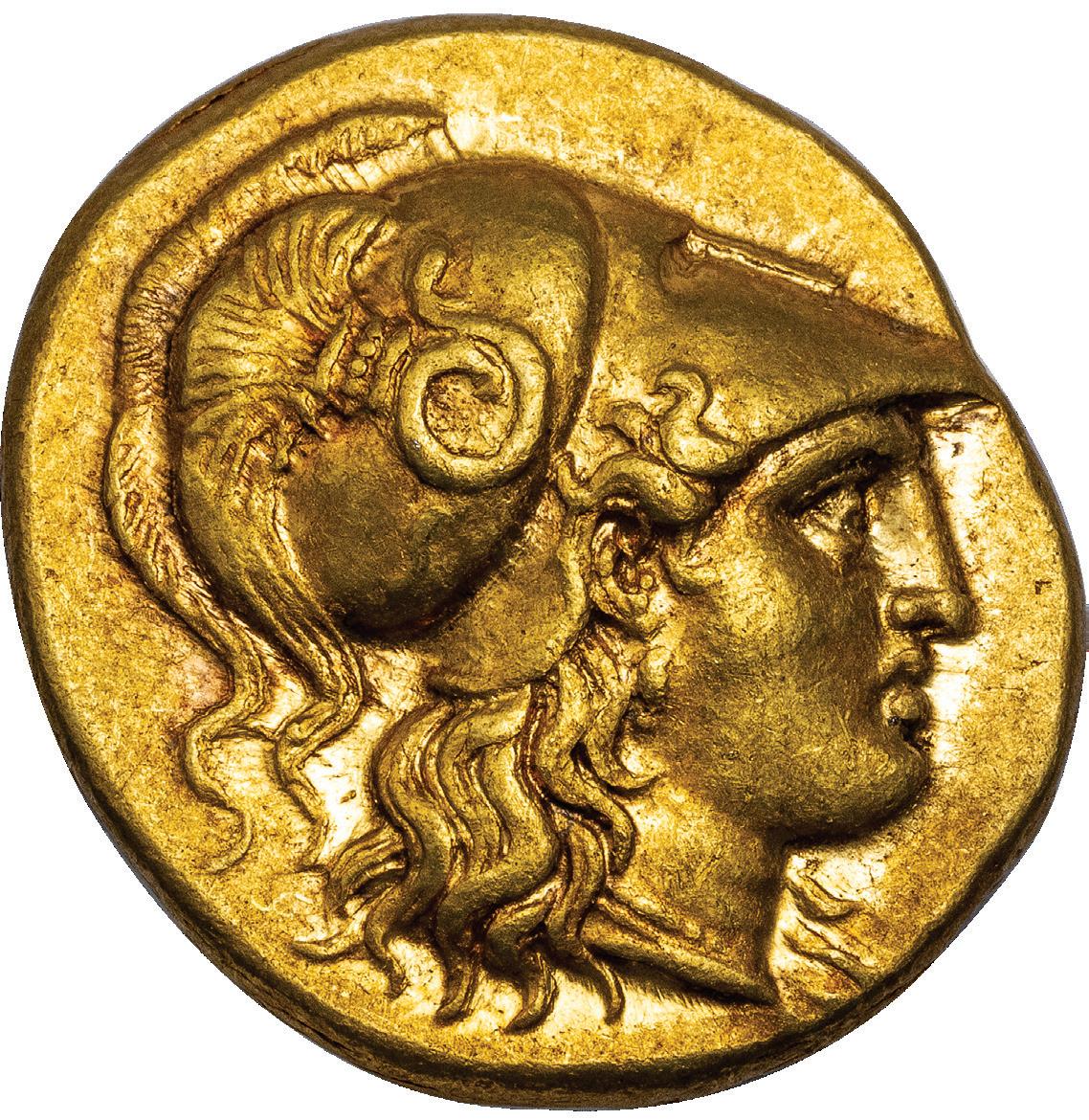
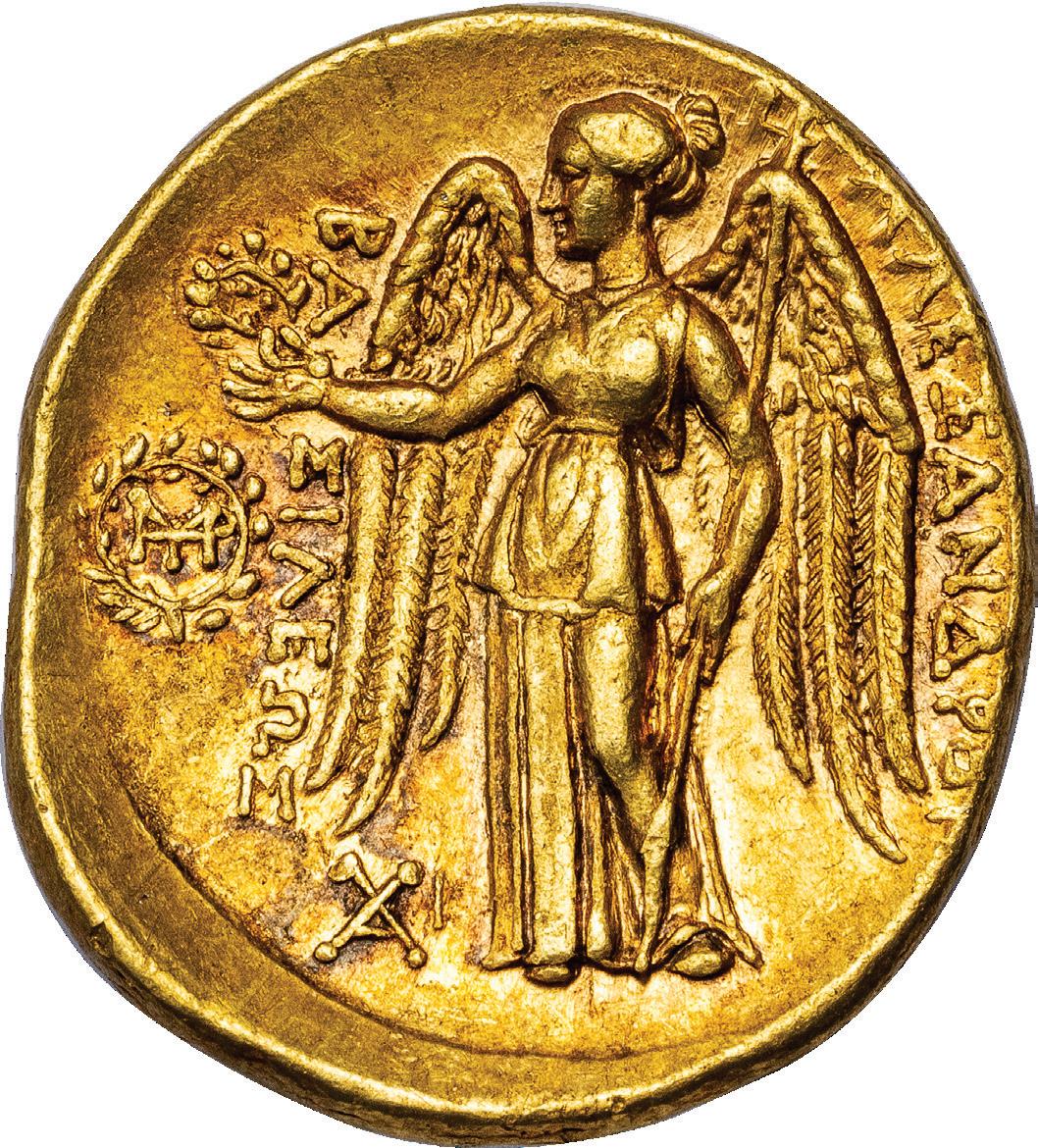
2

Vilmar Numismatics LLC PO Box 60 Big Indian, NY 12410 vilmar@aol.com www.vilmarnumismatics.com SHOWCASE IV MARCH 2024
ORDERING INFORMATION AND TERMS OF SALE
Email: vilmar@aol.com
(See our website for complete terms of sale and bibliographical information regarding abbreviations used)
Please place your orders by email and refer to the inventory number provided at the beginning of each listing. The coins also appear as individual records on our website. All coins are offered subject to prior sale and no order is valid until confirmed by us in writing and accompanied by a formal invoice.
OUR GUARANTEE
We unconditionally guarantee the authenticity of all our coins. A coin may be returned for any reason within 10 days, but we ask that you first contact us and ship the piece back fully insured. Upon receipt of the return and providing it is in the same condition as originally sent out, we will issue a refund, minus any shipping and credit card charges. This guarantee does not apply if coins are removed from encapsulation.
NGC ENCAPSULATED COINS
Most of our coins are sold encapsulated in NGC holders. Such coins have been evaluated, graded and encapsulated by NGC Ancients. NGC Ancients does not encapsulate any coins that in their opinion are fakes, of uncertain authenticity or have been repaired. In some cases we offer raw coins, and these may be encapsulated upon request.
PAYMENT TYPES
Title does not pass until payment is made in full. Payment must be received within 7 days of the sale date. In the United States payment may be made by bank wire, money order or personal check drawn on a US bank. CREDIT CARDS (VISA, MC, AMEX) are generally accepted but an additional 4% service charge will be added. Payments from overseas (all foreign countries including Canada) may be made by bank wire.
SALES TAX
Sales tax will apply to all merchandise delivered within New York State and other select states as required.
SHIPPING CHARGES FOR COINS
United States: $50 for FEDEX or EXPRESS MAIL (delivery in 1-2 days within the US). Foreign, including Canada: $120 via fully trackable Fed Ex or USPS Global Express Mail. It is the responsibility of the buyer to comply with customs regulations and pay for all duties/taxes in their country.
ILLUSTRATIONS USED IN THIS CATALOGUE
Coins are illustrated 1:1 and in various enlargements. In certain cases, we have also included images of older catalogues or publications wherein the specific piece is documented.
CREDITS
We are grateful to Oliver Hoover for his assistance in cataloguing and providing the historical notes, and to Mary Lannin for her editorial help. Photography and catalogue layout are the work of Alex Marinescu of Marinescu Designs, LLC.
WE WILL BE ATTENDING THE FOLLOWING SHOWS AND LOOK FORWARD TO SEEING YOU
Whitman Baltimore Expo, March 21–23, 2024
ANA 2024 World’s Fair of Money, Rosemont, IL, August 6–10, 2024
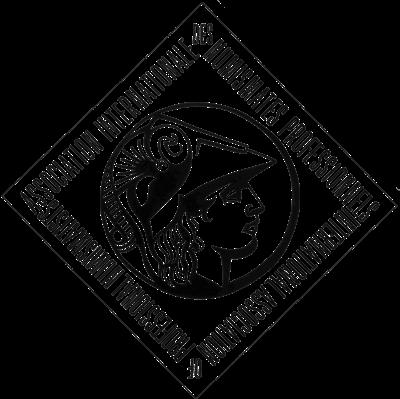


19203. CALABRIA. TARENTUM. Ca. 340–334 BC.
Silver didrachm (nomos), 7.84 g, 23 mm.
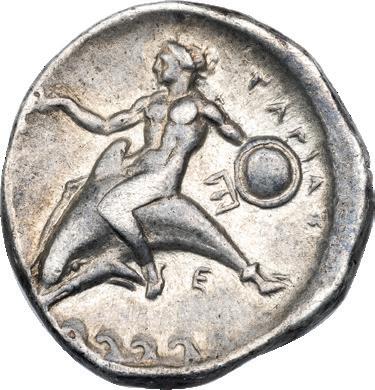
Obv. Youthful rider right, crowning his horse, as crouching boy below removes stone from the horse’s hoof, Φ in right field. Rev. TAPAΣ, dolphin rider left, holding cantharus and trident, shield slung on arm, E above waves below.
Fischer–Bossert Group 50, 695 (O262/R542); Vlasto 510 (same dies); Rutter, HN Italy, 888; HGC 1, 786.
NGC graded VF, Strike 5/5, Surface 3/5, “graffito,” a variety featuring one of the most charming scenes on Greek coinage.
The Tarentine nomos series is well known for its depictions of all aspects of ancient horsemanship, but this particular piece is especially remarkable for its sensitive portrayal of the moments after a horse race, the most popular event of the ancient Olympic games. Here the youthful jockey places the laurel crown of victory on the head of his horse while another youth (perhaps a stable boy) attends to the horse’s front hoof. It is unclear whether he is removing a pebble lodged there during the race, as is sometimes suggested, providing a more general cleaning, or merely inspecting it for anything that might cause injury to the winning animal. $ 2250
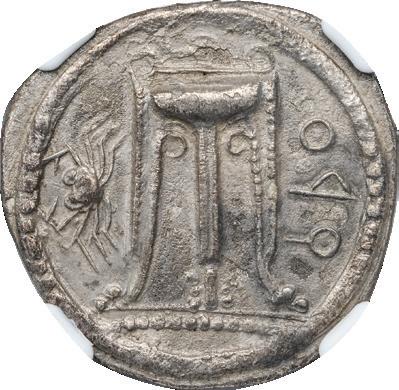
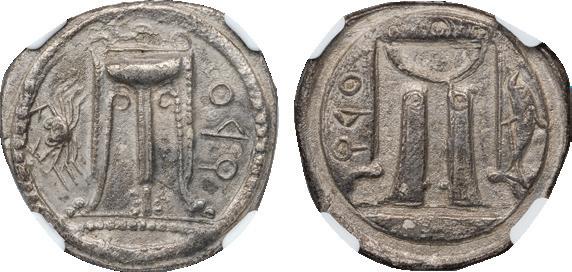
19371. BRUTTIUM. CROTON. Ca. 480–430 BC.
Silver stater, 7.41 g, 23 mm.
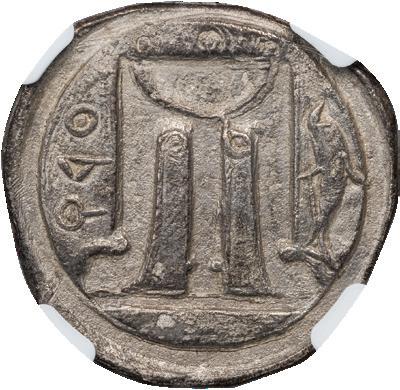
Obv. (K)PO, elaborate tripod, legs decorated by long volute ornaments and lion’s feet, crab in left field. Rev. (K)PO, incuse tripod, dolphin swimming vertically in right field.
Rutter, HN Italy, 2100 var.; HGC 1, 1449; SNG ANS 309.
NGC graded AU, Strike 5/5, Surface 2/5, slight surface roughness, but a delightful type depicting two sea creatures on one coin. $ 850
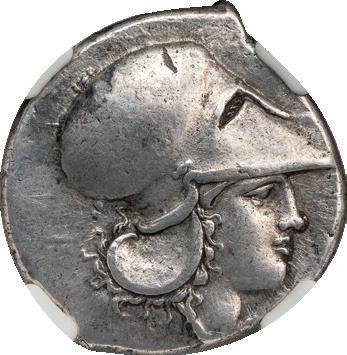

19088. BRUTTIUM. HIPPONIUM (VIBO). Ca. 300–250 BC.
Silver stater, 8.45 g, 20 mm.

Obv. Pegasus flying left, caduceus below. Rev. Head of Athena right, wearing large Corinthian helmet. Pegasi 1/5 (same dies); Rutter, HN Italy, 2242; SNG ANS 503 (as Locri Epizephrii), SNG Delepierre 479, SNG Lloyd 633; HGC 1, 1397.
Ex Stack’s Bowers, 1/16/2018, lot 22010.
NGC graded CHOICE XF, Strike 5/5, Surface 3/5, a very scarce emission of the Pegasus type, here minted with the Athena design as an obverse die. $ 3700
5
AN OLYMPIC VICTORY CELEBRATED AT RHEGIUM
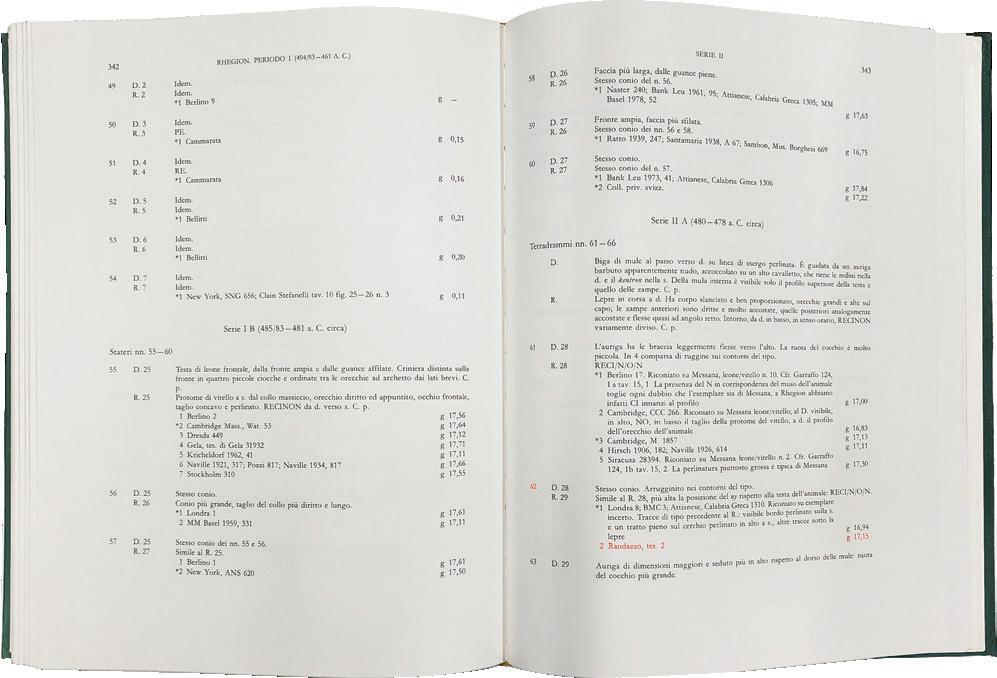
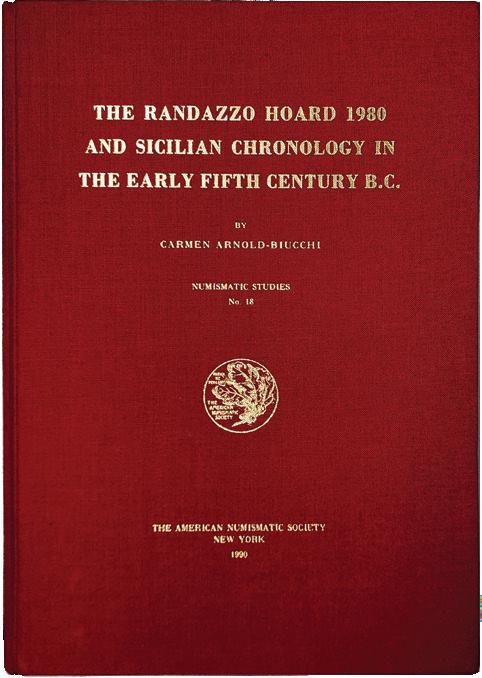

19408. BRUTTIUM. RHEGIUM. Ca. 480–474 BC.
Silver tetradrachm, 17.14 g, 23 mm. Issue of 480–478 BC.

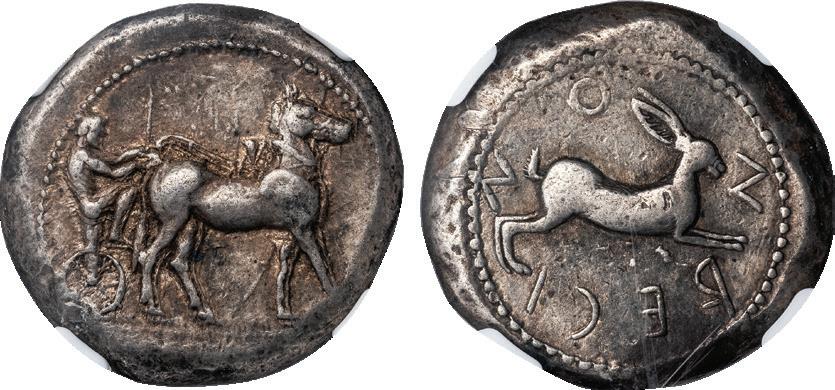
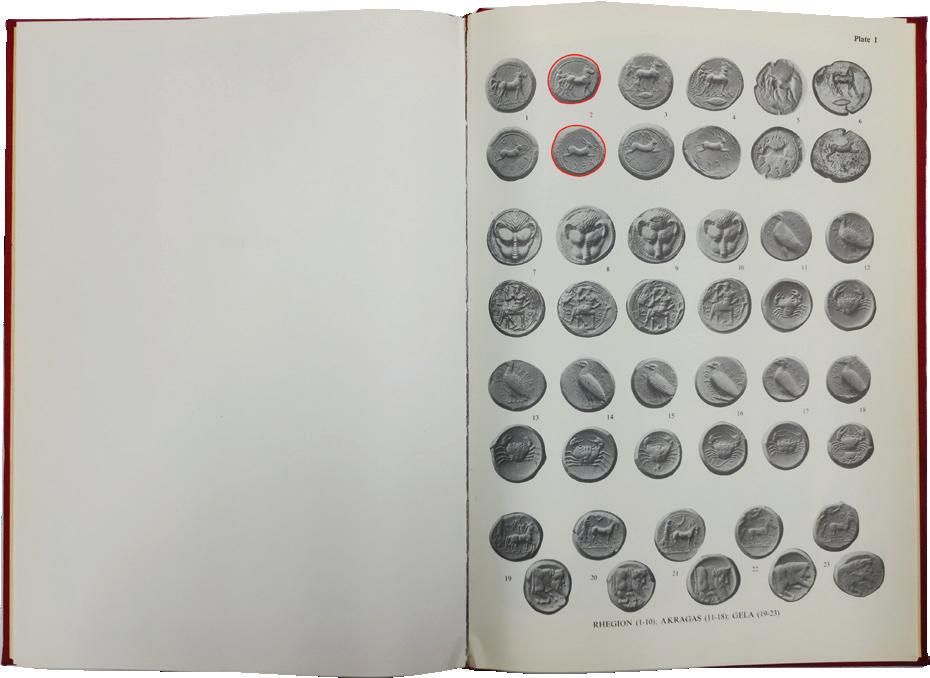
Obv. Charioteer in biga of mules right. Rev. RECINON (retrograde), hare springing right.
Caltabiano, Monetazione, Rhegium series IIA, 62.2 (D28/R29, this coin cited); Randazzo Hoard 2 (this coin listed and illustrated); Rutter, HN Italy, 2472; HGC 1, 1632.
NGC graded VF, Strike 5/5, Surface 4/5, “light marks,” a rare issue of Rhegium using the types of Messana.
The obverse type of this coin celebrates a victory won by Anaxilas, the tyrant of Rhegium (c. 494–476 BC), in the Olympic anape (mule–biga race) in 484 or 480 BC. It went on to be the standard type for coins struck at Rhegium and Messana (the refounded Zankle) in northern Sicily under Anaxilas and his successors. The hare reverse, on the other hand, was a standard type used at Messana under the Anaxilids. Together these types advertise Anaxilas’ rule of both cities and the control of the Strait of Messina that this afforded him.
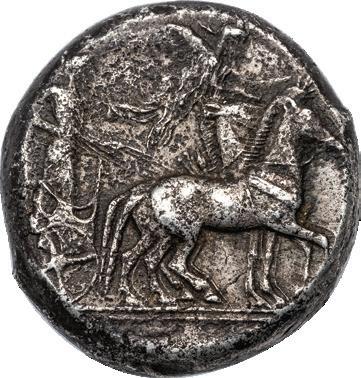
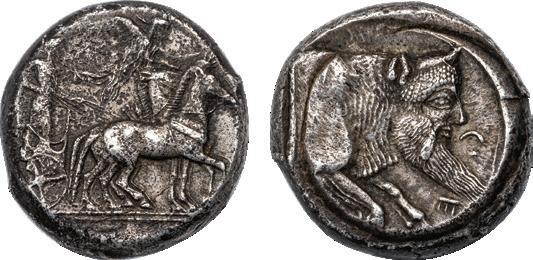
19212. SICILY. GELA. Ca. 480–470 BC.
Silver tetradrachm, 17.11 g, 22 mm.
$ 5600
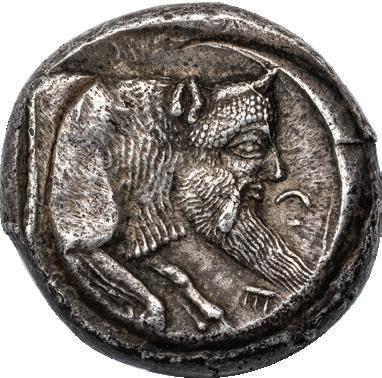
Obv. Charioteer driving biga right, Nike flying right above, crowning the horses. Rev. CE[ΛAS], protome of man–headed bull right. Jenkins, The Coinage of Gela, 104 (O32/R59); SNG ANS 22 (same dies); SNG Copenhagen 251 (same dies); HGC 2, 338.
Ex Lanz 16, 4/24/1979, lot 41.
Near EF, porosity on obverse, edge scrape and small marks consistent with prior mounting.
$ 4500
6
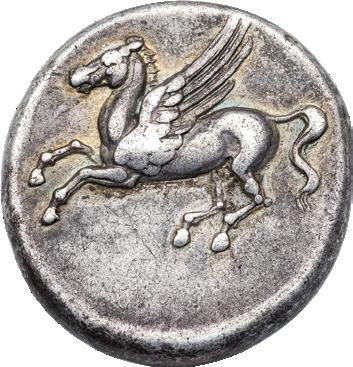

19208. SICILY. LEONTINI. 4th CENTURY BC.
Silver stater, 8.33 g, 21 mm.

Obv. Pegasus flying left. Rev. ΛEO[NT]INON, head of Athena right, wearing Corinthian helmet, barley grain in left field.
Pegasi 1/4 (same dies); HGC 2, 707.
Ex Künker eLive Auction 74, 11/14/2022, lot 49.
NGC graded VF, Strike 4/5, Surface 4/5, dark gray toning, rare issue in the large Pegasi series, one of only 14 specimens in current market records. $ 1450
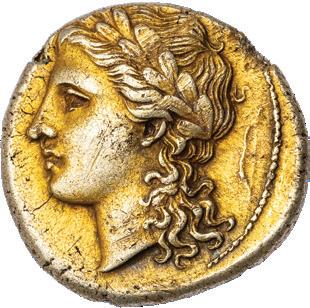
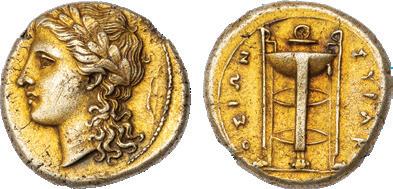
19166B. SICILY. SYRACUSE. AGATHOCLES, 317–289 BC.
Electrum 50 or 25 litrai, 3.54 g, 16 mm.
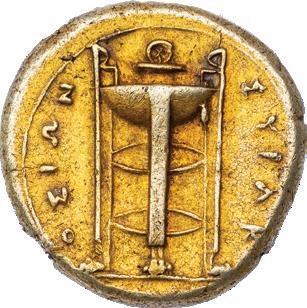
Obv. Laureate head of Apollo left, bow in right field. Rev. ΣYPAKOΣIΩN, tripod.
HGC 2, 1294; SNG ANS 630; G.K. Jenkins. “The Electrum Coinage at Syracuse,” in Essays Robinson, p. 157, Group C, O17/R34 (citing two specimens, in Boston and the Jameson collection).
From the estate of Robert Haber, acquired mostly in the 1980s–early 2000s.
NGC graded AU, Strike 5/5, Surface 3/5, FINE STYLE, “scuff,” light golden color, seldom seen variety with only 9 specimens in market records, dies of a particularly elegant style. $ 5000

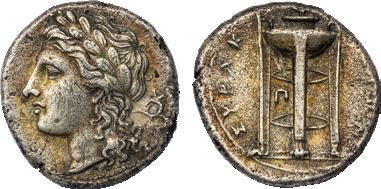
19166A. SICILY. SYRACUSE. AGATHOCLES, 317–289 BC.
Electrum 50 or 25 litrai, 3.49 g, 16 mm.

Obv. Laureate head of Apollo left, wreath in right field. Rev. ΣYPAKOΣIΩN, tripod, Π between its legs.
HGC 2, 1294; SNG ANS 630; G.K. Jenkins. “The Electrum Coinage at Syracuse,” in Essays Robinson, p. 158, O26/unlisted reverse die where the legend reads clockwise rather than counterclockwise orientation that is the norm.
From the estate of Robert Haber, acquired mostly in the 1980s–early 2000s.
NGC graded CHOICE XF, Strike 4/5, Surface 3/5, FINE STYLE, “marks,” pale yellow color, a very rare variety with only 3 specimens in market records. $ 4000
7
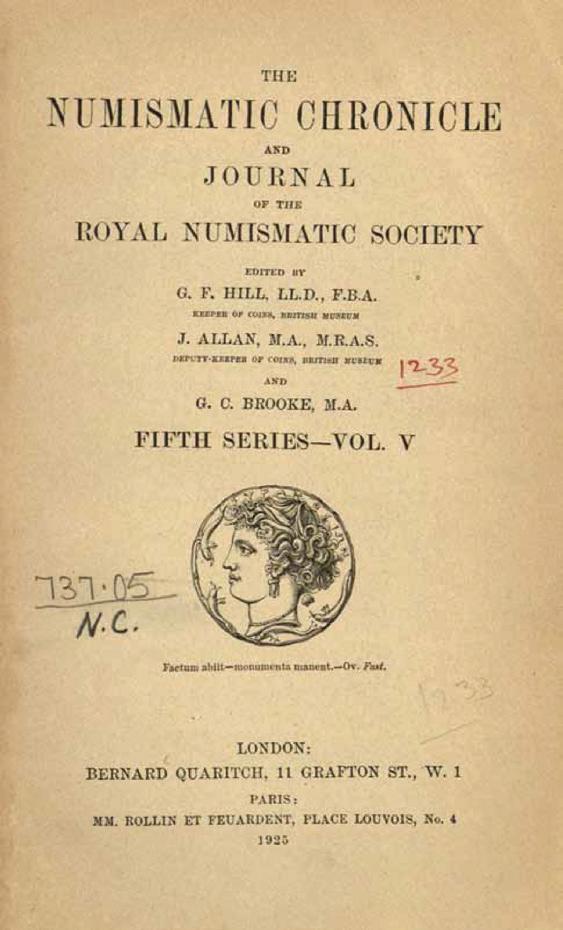
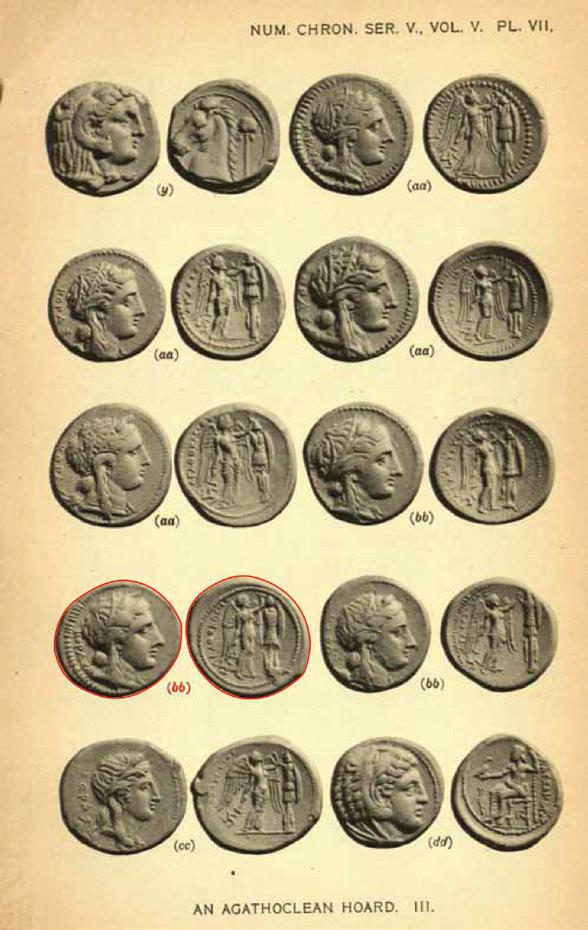

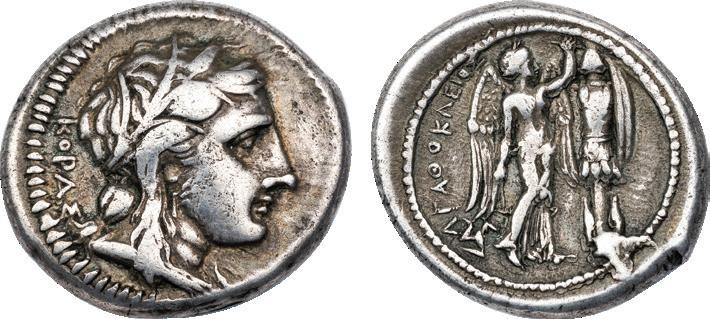
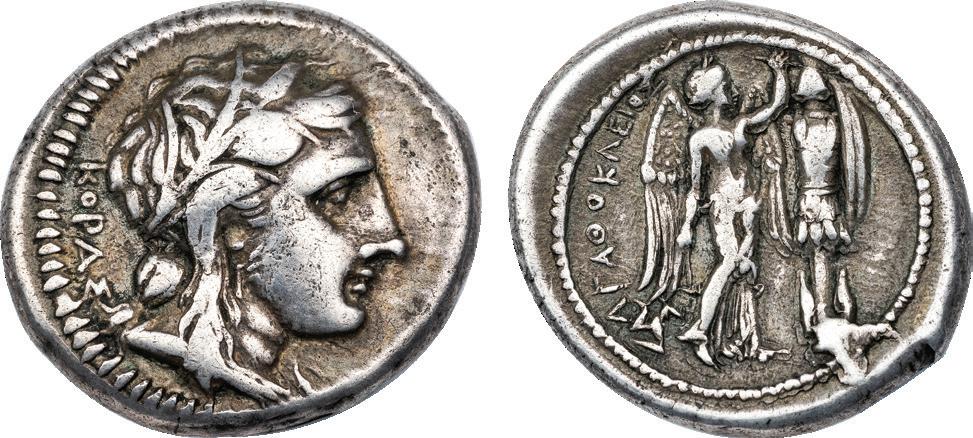
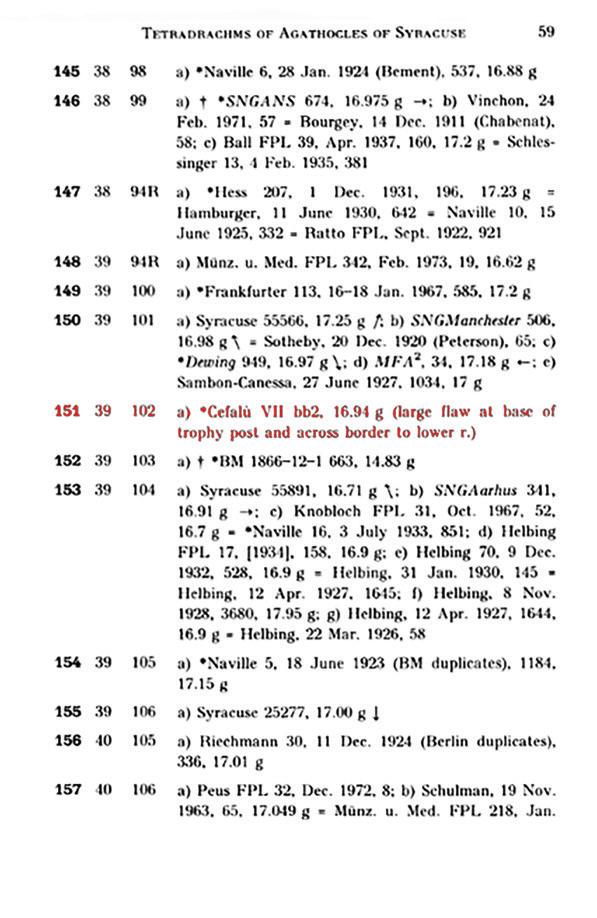
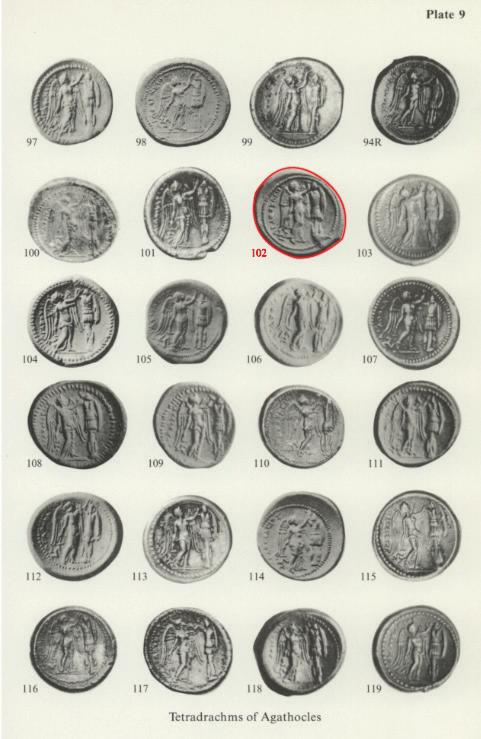
19215. SICILY. SYRACUSE. AGATHOCLES, 317–289 BC.
Silver tetradrachm, 16.93 g, 27 mm. Issue of ca. 305–295 BC.
Obv. KOPAΣ, wreathed head of Kore right. Rev. AΓAΘOKΛEIOΣ, Nike standing right, erecting trophy, triskeles beneath left wing. Ierardi 151 (O39/R102 – this coin listed and reverse illustrated); HGC 2, 1536.
Ex Peus 291, 1977, lot 164; ex A. H. Lloyd Collection, published by Lloyd, “A recently discovered Hoard of Greek and Siculo–Punic Coins,” Numismatic Chronicle V, 1925, 151 ff, this coin illustrated on plate 7 (bb on left), but not included in SNG Lloyd.
NGC graded VF, Strike 5/5, Surface 4/5, small die break at the base of the trophy, old gray cabinet toning.
This was part of a hoard of 67 tetradrachms found in late 1924 near Cefalu and acquired by Dr. Albert Hugh Lloyd. This particular specimen is illustrated on plate 7 of Lloyd’s article on the hoard. The hoard was subsequently published as the “Cefalu 1925 hoard,” IGCH 2154 in the Index of Greek Coin Hoards $ 4800
8
FROM THE CEFALU 1925 HOARD PUBLISHED BY LLOYD AND IERARDI
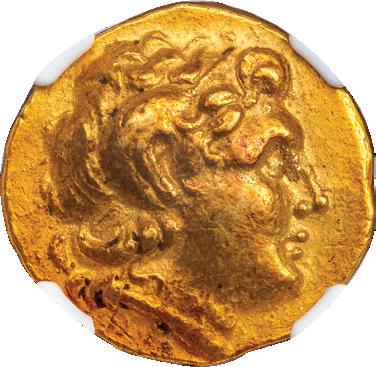
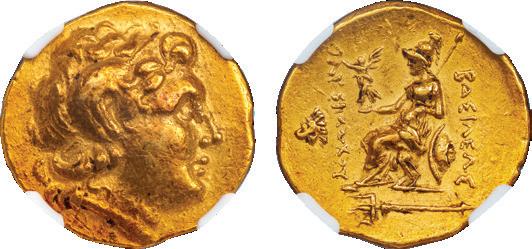
17530. KINGDOM OF THRACE. LYSIMACHUS, 305–281 BC.
Gold stater, 8.50 g, 21 mm. Posthumous emission of Byzantium, ca. 260–250 BC.

Obv. Head of deified Alexander the Great right, with the horn of Ammon. Rev. ΒΑΣΙΛΕΩΣ ΛΥΣΙΜΑXΟΥ, Athena enthroned left, holding Nike crowning Lysimachus’ name, lion head in outer left field, plain trident in exergue.
Marinescu, Making and Spending Money along the Bosporus: The Lysimachi Coinages Minted by Byzantium and Chalcedon and their Socio–Cultural Context (Columbia University Dissertation, 1996), issue 47, no. 122 (same dies).
NGC graded CHOICE XF, Strike 4/5, Surface 3/5.
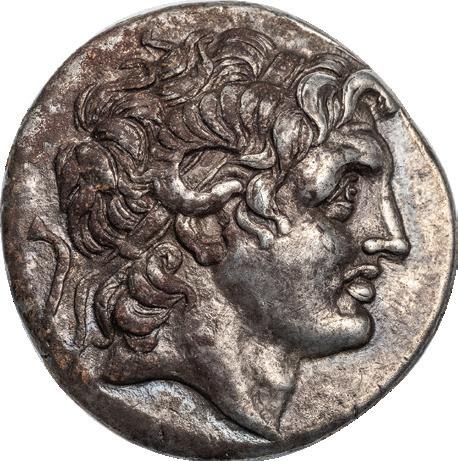
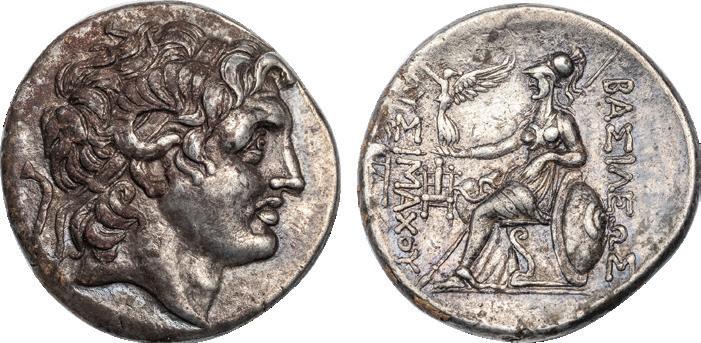
19190. KINGDOM OF THRACE. LYSIMACHUS, 305–281 BC.
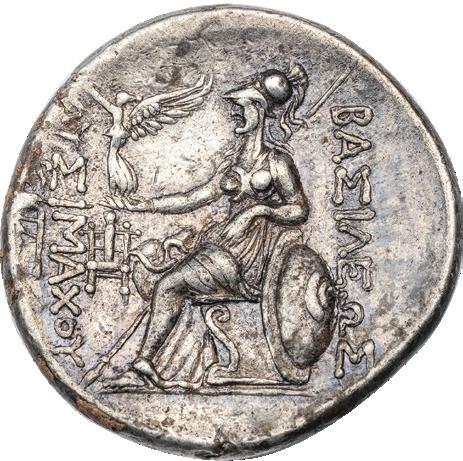
Silver tetradrachm, 16.98 g, 29 mm. Early posthumous emission of Aenus, ca. 281–260 BC.
$ 5800
Obv. Head of deified Alexander the Great right, with the horn of Ammon. Rev. ΒΑΣΙΛΕΩΣ ΛΥΣΙΜΑXΟΥ, Athena enthroned left, holding Nike crowning Lysimachus’ name, lion head device on shield, tripod in outer left field, cult image in left field. Thompson ––; Müller ––; HGC 3, 1283.
From the estate of Robert Haber, acquired mostly in the 1980s–early 2000s.
NGC graded CHOICE XF, Strike 5/5, Surface 3/5, struck in high relief, dark find patina, an extremely rare and seldom seen emission.
$ 1950
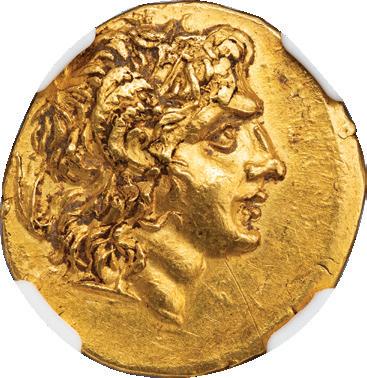
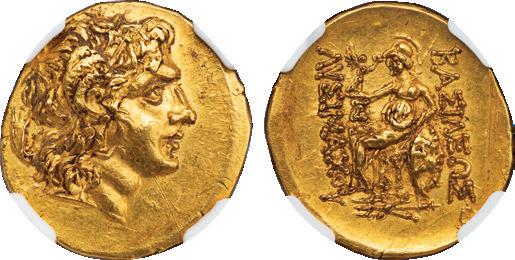
17240. KINGDOM OF THRACE. LYSIMACHUS, 305–281 BC.
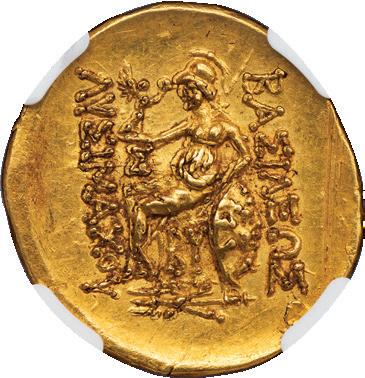
Gold stater, 8.36 g, 22 mm. Posthumous issue of Byzantium from the Mithridatic Wars, ca. 110–100 BC.
Obv. Head of deified Alexander the Great right, with the horn of Ammon, here bearing the features of Mithridates VI. Rev. ΒΑΣΙΛΕΩΣ ΛΥΣΙΜΑXΟΥ, Athena enthroned left, holding Nike crowning Lysimachus’ name, Σ in inner left field, BY on throne, trident in exergue. Callataÿ, pl. 38K (same obverse die); CNG 60, lot 448 (same dies).
Ex Vilmar Numismatics FLP II, Winter 2021, no. 4; ex Künker 352, 9/25//2021, lot 1010; ex Julius Jenke (Munich), 1952. NGC graded CHOICE AU, Strike 4/5, Surface 2/5, “marks.” An extremely rare variety, this is part of a tightly knit group of gold issues of Byzantium. These coins all depict Mithridates as a “new Alexander” championing the Greek cause against the Romans. Mithridates employed this practice of altering the features of Alexander to resemble his own not only on the gold of Byzantium, but also on some of the silver tetradrachms struck by the Pontic city of Odessus. $ 8750
9
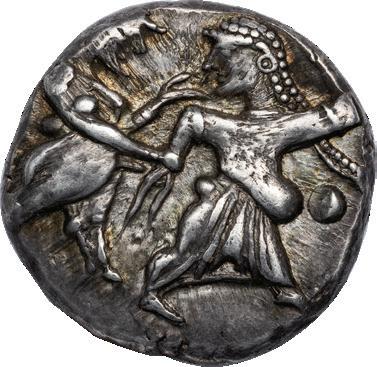

19094. MACEDON. SIRIS. Ca. 525–480 BC.

Silver stater, 9.81 g, 21 mm. This issue is sometimes also attributed to Berge or “Lete.”
Obv. Ithyphallic stater striding right, grabbing hand of fleeing nymph right and touching her chin, pellet in field. Rev. Quadripartite incuse square with crossed diagonal lines.
HGC 3, 531.
Ex Crédit Suisse Zurich, Monetarium FPL 60, 1993, no. 28.
NGC graded CHOICE XF, Strike 4/5, Surface 5/5, dies engraved in fine Archaic Greek style and struck in high relief.


19163. MACEDONIAN KINGDOM. PHILIP II, 359–336 BC.
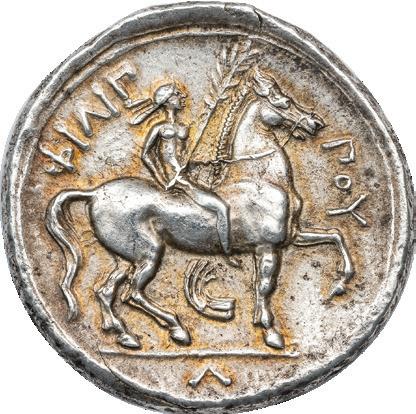
Silver tetradrachm, 14.42 g, 25 mm. Lifetime or early posthumous issue of Amphipolis, ca. 342/1–329/8 BC.
$ 3500
Obv. Laureate head of Zeus right. Rev. ΦIΛIΠΠOY, youth on horseback right, wearing fillet, holding palm branch, prow below, Λ in exergue.
Le Rider, 428 (same dies), citing one specimen in the ANS.
Ex Spink 258, 1/28/ 2019, lot 1493 = Künker 288, 3/13/2017, lot 114.
NGC graded CHOICE XF, Strike 5/5, Surface 3/5, FINE STYLE, “flan flaw,” with iridescent highlights throughout and dies of exceptional style; this variety is extremely rare, with Le Rider citing only three specimens from two die combinations (Le Rider 428–429).
$ 5500

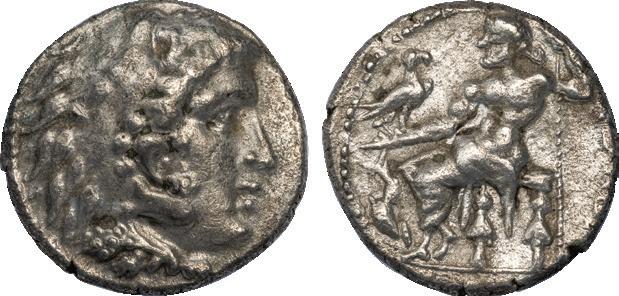
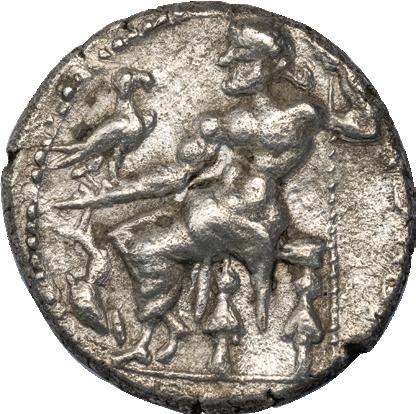
18449. MACEDONIAN KINGDOM. ALEXANDER III, THE GREAT, 336–323 BC.
Silver tetradrachm, 14.42 g, 25 mm. Posthumous issue of an uncertain Eastern Mint sometimes identified as a “Celtic Issue from Lykaonia” or “Galatian Issue,” ca. 250–200 BC.
Obv. Head of young Heracles right in lion skin headdress. Rev. [ΑΛΕΞΑΝΔΡΟΥ], Zeus enthroned left, holding eagle and scepter, dolphin swimming downward in left field.
Price B3 (as “barbaric”).
NGC graded XF, Strike 4/5, Surface 3/5, “edge scuff,” a rare emission from a short–lived series. $ 850
10
The tetradrachm below, struck in the name of Alexander, and the bronze unit struck in the name of Philip III, both bear the same control monogram, K–I, indicating that they were produced at much the same time by the mint of Miletus. They are part of the larger series signed by K–I and struck in a variety of denominations, including gold staters and various fractional coins in all metals.


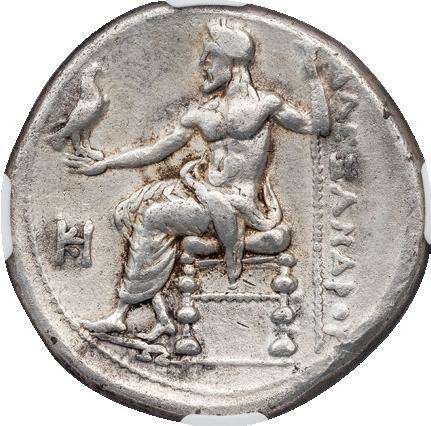
19263. MACEDONIAN KINGDOM. ALEXANDER III, THE GREAT, 336–323 BC.
Silver tetradrachm, 16.76 g, 26 mm. Early posthumous issue minted at Miletus, ca. 323–319 BC.
Obv. Head of young Heracles right in lion skin headdress. Rev. ΑΛΕΞΑΝΔΡΟΥ, Zeus enthroned left, holding eagle and scepter, K–I control monogram in left field.
Price 2120.
Ex M. R. Roberts, Wynyard Coin Centre, Sydney, Australia, with his original tag.
NGC graded CHOICE VF, Strike 5/5, Surface 3/5, “edge marks.”
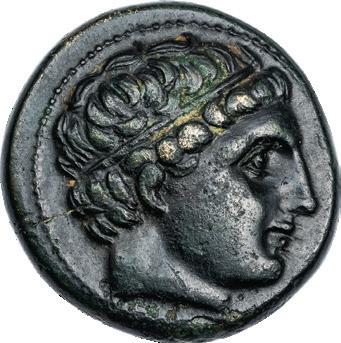
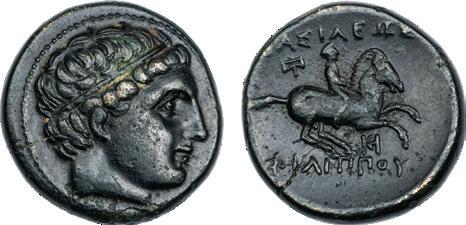
19177. MACEDONIAN KINGDOM. PHILIP III, 323–317 BC.
Bronze unit, 5.58 g, 19 mm. Issue of Miletus.
$ 650
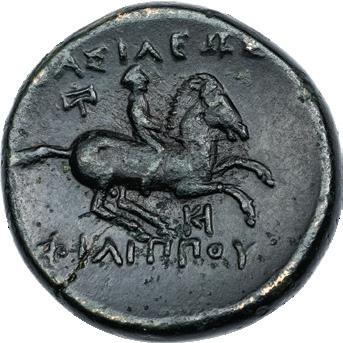
Obv. Diademed head of Apollo right. Rev. ΒΑΣΙΛΕΩΣ ΦΙΛΙΠΠΟΥ, rider on rearing horse right, double–axe in left field, K–I monogram below horse.
Price P64.
From the estate of Robert Haber, acquired mostly in the 1980s–early 2000s.
NGC graded CHOICE XF, Strike 5/5, Surface 4/5, rare emission.
$ 300
11
DIFFERENT DENOMINATIONS OF SAME PHILIP III ISSUE OF MILETUS
RARE ALEXANDER TYPE ISSUE WITH RECUT CONTROL MONOGRAM FROM THE ANTIOGONID ADMINISTRATION AT BABYLON
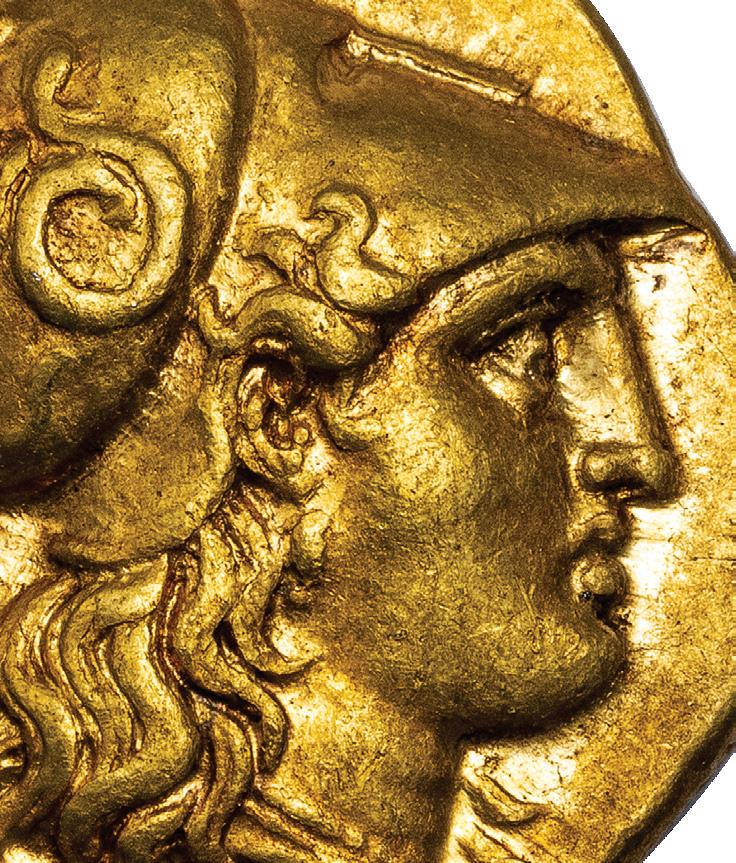
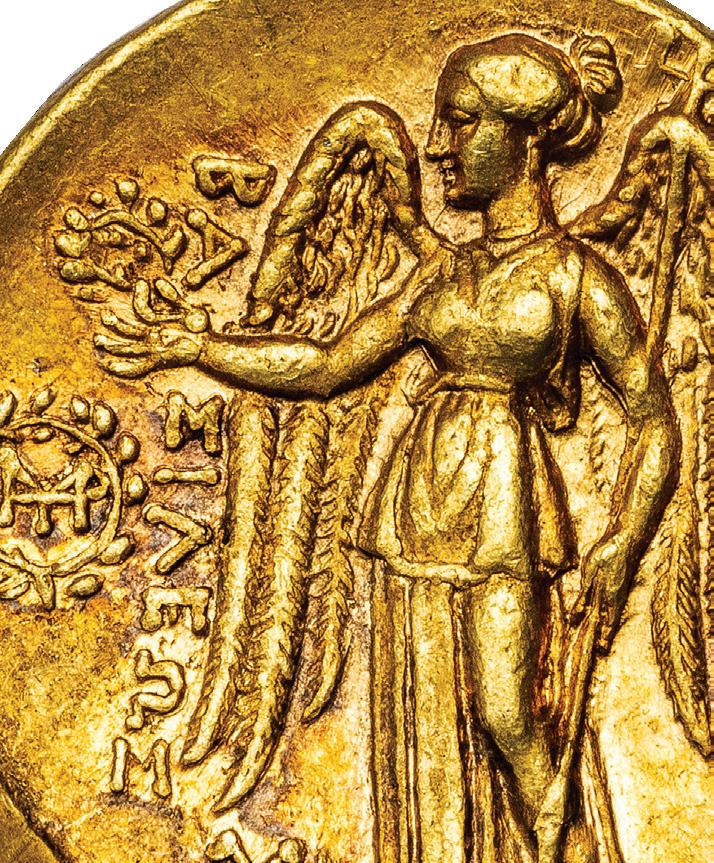
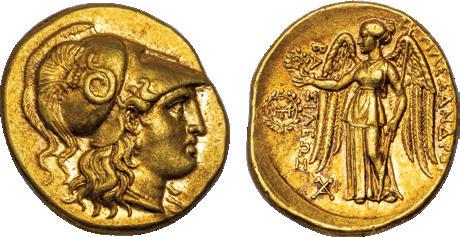
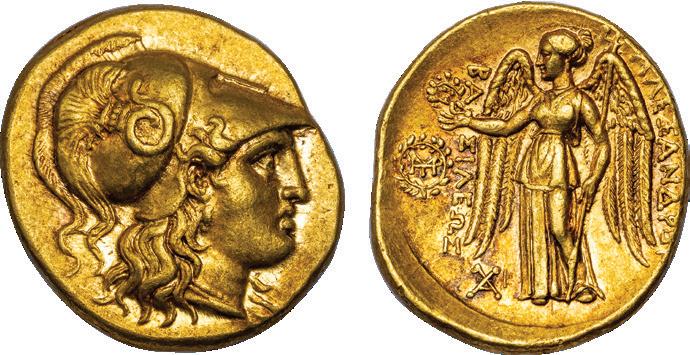

Gold stater, 8.53 g, 20 mm. Early posthumous issue of Babylon, ca. 315–312 BC. Obv. Head of Athena right, wearing large Corinthian helmet with snake ornament below the plume. Rev. ΒΑΣΙΛΕΩΣ ΑΛΕΞΑΝΔΡΟΥ, Nike standing, looking left, holding wreath in right hand and stylis over left shoulder, monogram in wreath in outer left field, XA [P] control monogram below left wing.
Price 3720; American Numismatic Society (1967.152.312), same reverse die. NGC graded as AU, Strike 5/5, Surface 4/5, FINE STYLE, “light marks,” one of the most elusive varieties from this period known from a handful of specimens, and an exceptionally attractive Alexander stater minted at Babylon with a “full–head” Nike.
This beautiful and numismatically important stater was struck in Babylon by the administration established by Antigonus Monophthalmus for the satrapy of Babylonia in the period ca. 315–312 BC. Although the city and the satrapy had been administered by Seleucus I, the founder of the Seleucid dynasty since 320 BC, he was forced to flee to the safety of Egypt at the arrival of Antigonus in 315 BC. Seleucus was only able to return and reclaim Babylon with a handful of men three years later, in 312 BC. During his absence, the Antigonid administration struck gold and silver coins with the types of Alexander the Great, often featuring an elaborate monogram within a laurel wreath. Some of these have been mistakenly attributed to a so–called “Imperial Workshop” of Seleucus I in the past (SC 81–85) but are now recognized as part of the Antigonid Babylonian series.
This stater is especially important for understanding the internal chronology of the series because the monogram below Nike’s left wing appears to be recut in the die over an earlier monogram involving the letter rho. Up to now this detail has gone unnoticed and certainly is not mentioned by Martin Price. Price 3717, which features an eta–rho monogram below the left wing, seems like the best candidate for the monogram originally cut into the die (cf. Berlin 1875 Prokesch–Osten for this variety); on Price 3720 the main part of the control, the eta, seems to have been erased and replaced by the XA monogram, but for some reason the terminal rho was left in place. If correct, then this coin provides clear proof that Price 3720 staters were struck at Babylon after Price 3717, confirming Martin Price’s proposed arrangement. $ 12500
12
19411. MACEDONIAN KINGDOM. ALEXANDER III, THE GREAT, 336–323 BC.
IMPRESSIVE MINT ERROR DOUBLING ALEXANDER’S FACE
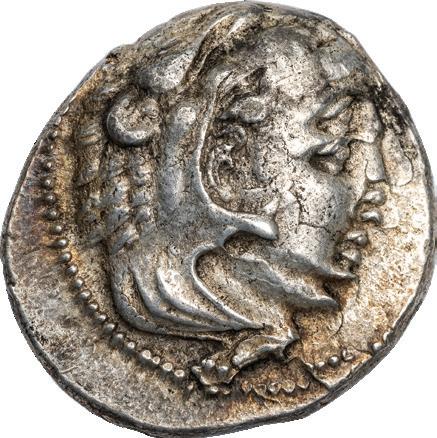
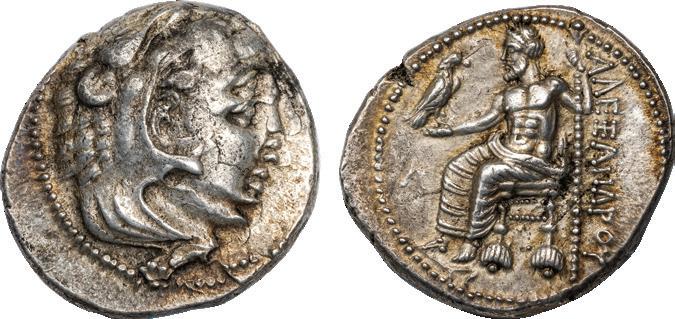
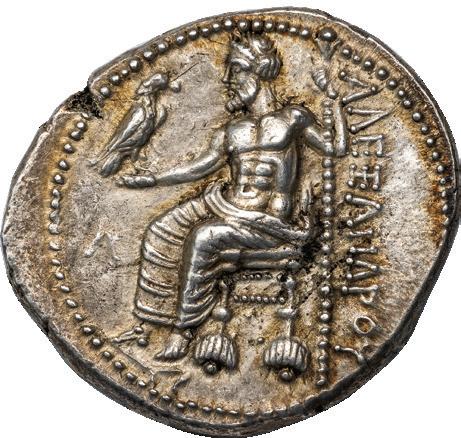
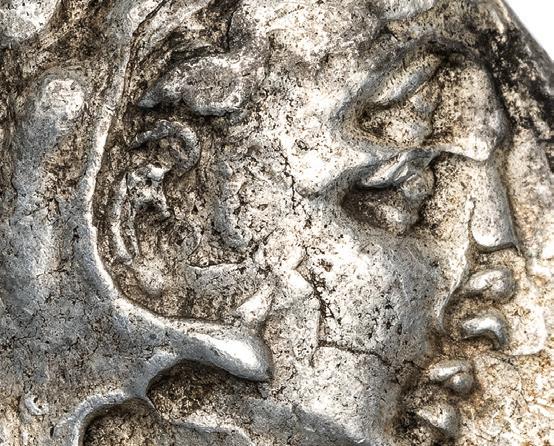
19395. MACEDONIAN KINGDOM. ALEXANDER III, THE GREAT, 336–323 BC.
Silver tetradrachm, 17.18 g, 27 mm. Posthumous issue of Aradus, ca. 320/319–315 BC, struck under Ptolemy I.
Obv. Head of young Heracles right in lion skin headdress. Rev. ΑΛΕΞΑΝΔΡΟΥ, Zeus enthroned left, holding eagle and scepter, AP monogram in left field, monogram under throne.
Price 3426 (with the traditional attribution to Byblus).
NGC graded CHOICE XF, Strike 3/5, Surface 4/5, “die shift.” A remarkable double strike that duplicates the upper portion of Alexander’s face. $ 1950
A HEMIDRACHM OF DEMETRIUS POLIORCETES FROM THE SAMUEL POZZI COLLECTION
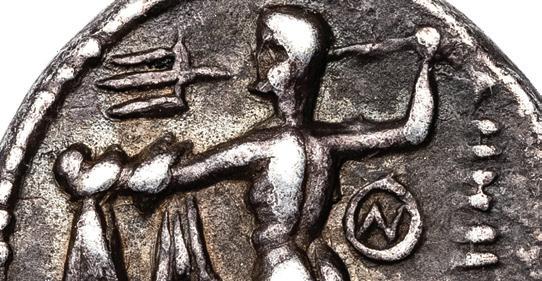
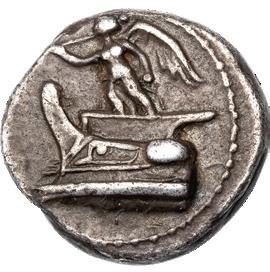

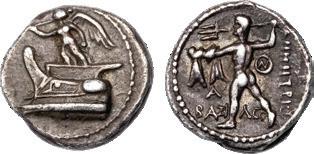
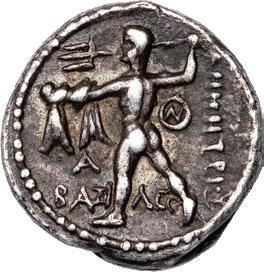
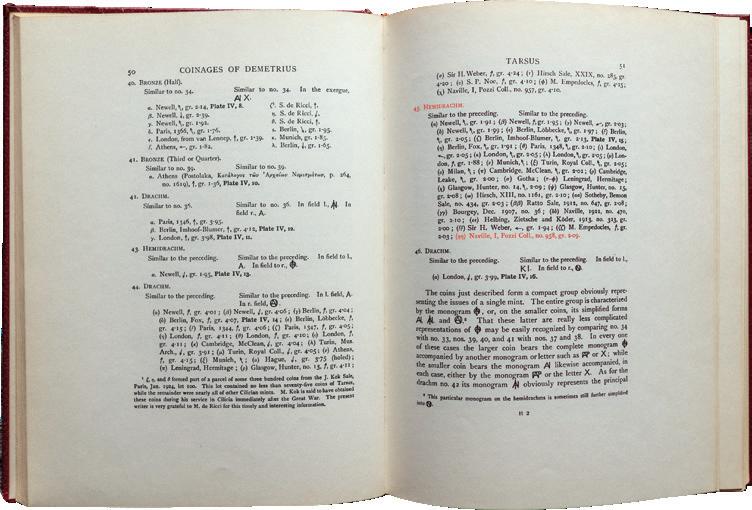
19387. KINGDOM OF MACEDON. DEMETRIUS POLIORCETES, 306–283 BC.
Silver hemidrachm, 2.09 g, 13 mm. Issue of Tarsus, ca. 298–295 BC.
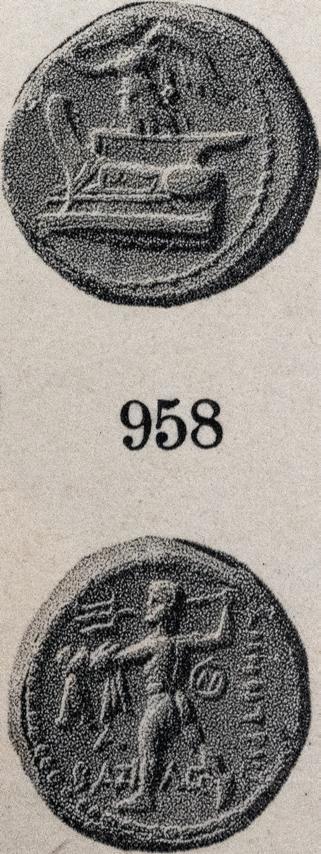
Obv. Nike standing on ship’s prow left, blowing trumpet. Rev. ΒΑΣΙΛΩΣ ΔΗΜΙΤΡΙOΥ, Poseidon striding left, preparing to throw trident, A in left field, AI within circle control monogram in right field.
Published: Newell, Demetrius, 45.ζζ (this specimen cited).
Ex Jean Vinchon, Paris, private stock = ex Samuel Pozzi Collection = Pozzi (Boutin), 2011 = Naville I, 3/14/1921, lot 958.
NGC graded CHOICE VF STAR, Strike 5/5, Surface 5/5, the prestigious Pozzi provenance listed on label.
Demetrius “the Besieger” was one of the more colorful players in the struggle for power following Alexander’s death. His coinage features Poseidon, god of the sea, recalling Demetrius’ claims to glory as being a “Besieger of Cities.” This series depicts a triumphal monument commemorating a naval victory, with Nike, goddess of victory, blowing a trumpet from the prow of a ship. The figure is reminiscent of the “Victory of Samothrace,” the famous marble figure in the Louvre Museum. This specimen, a hemidrachm from the Nike on prow/Poseidon series, was once in the collection of Dr. Samuel Pozzi, one of the greatest collectors of turn–of–the–century Europe. $ 4750
13


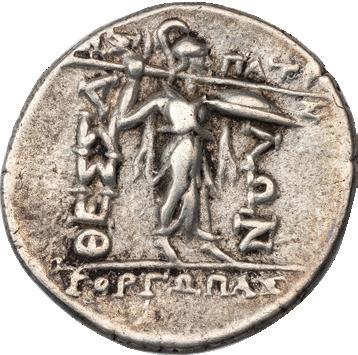
19195. THESSALIAN LEAGUE. 2nd–1st CENTURY BC.
Silver stater (double victoriatus), 6.22 g, 20 mm. Issue of magistrates Sosipatros and Gorgopas.
Obv. Laureate head of Zeus right. Rev. ΘEΣΣAΛΩN, Athena Itonia striding right, magistrate names above and in exergue.
HGC 4, 209.
From the estate of Robert Haber, acquired mostly in the 1980s–early 2000s.
NGC graded CHOICE VF, Strike 5/5, Surface 4/5.
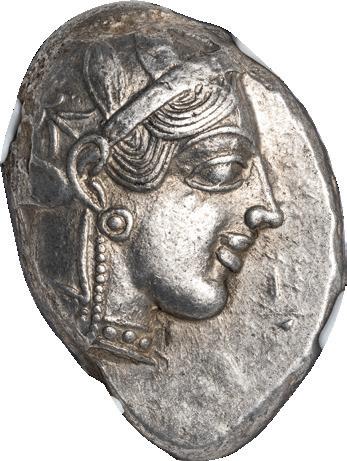
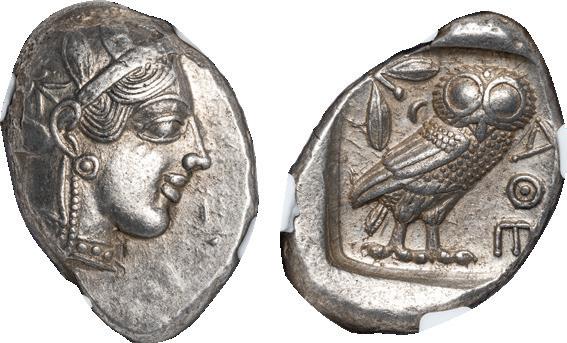
19459. ATTICA. ATHENS. Ca. 440-404 BC.
Silver tetradrachm, 17.41 g, 29 mm.
$ 300

Obv. Helmeted head of Athena right. Rev. ΑΘΕ, owl standing right, head facing, olive sprig and crescent in left field, all within incuse square.
HGC 4, 1597; Kroll 8; SNG Copenhagen 31-40; Dewing 1591-1598.
NGC graded CHOICE XF, Strike 3/5, Surface 4/5, struck on a tidy, highly elongated planchet.
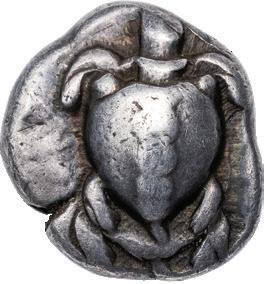
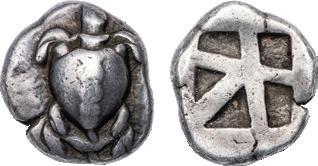
19207. ISLAND OF AEGINA. Ca. 480–457 BC.
Silver hemidrachm, 3.04 g, 14 mm.
$ 950
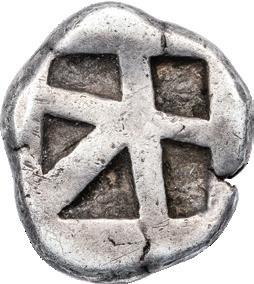
Obv. Sea turtle, its beaked head turned left, row of dots in “T–back” design along its shell. Rev. Incuse square with “skew” design.
HGC 6, 448; SNG Copenhagen 510.
NGC graded VF, Strike 4/5, Surface 4/5, “die shift,” an interesting double strike where the bottom of the turtle is clearly duplicated. $ 1850
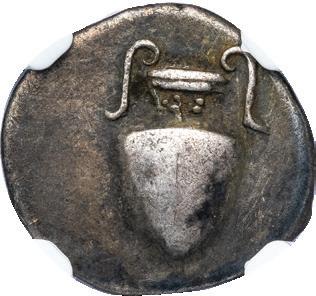
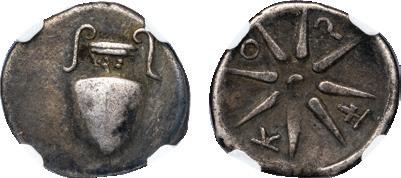
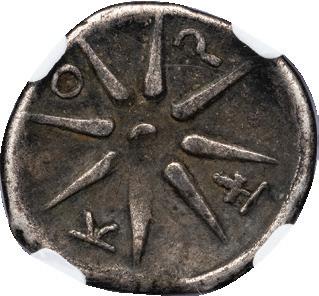
19302. ILLYRIA. GREEK ISLAND OF CORCYRA. Ca. 400–350 BC.
Silver hemidrachm, 15 mm.
Obv. Amphora. Rev. K–O–P within rays of Macedonian star, stylis at bottom.
HGC 6, 47; SNG Copenhagen 159.
NGC graded VF.
$ 575
14
EXTREMELY RARE YEAR 161 DATE OF THE BITHYNIAN TETRADRACHM SERIES
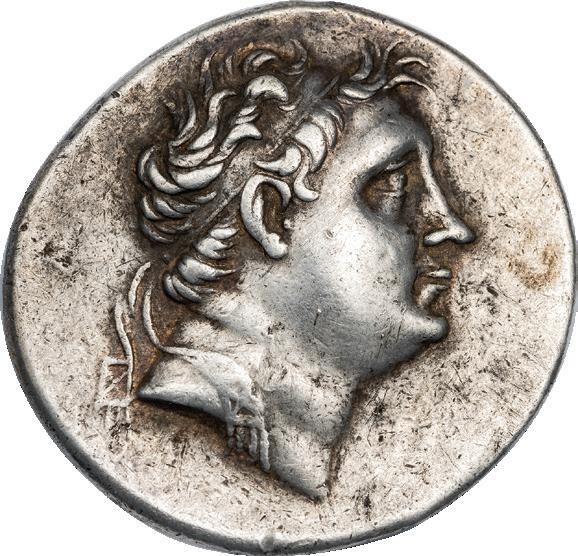

19188. BITHYNIAN KINGDOM. NICOMEDES II, 149–127 BC.
Silver tetradrachm, 16.54 g, 37 mm. Issue dated Bithynian Era 161 (137/6 BC).
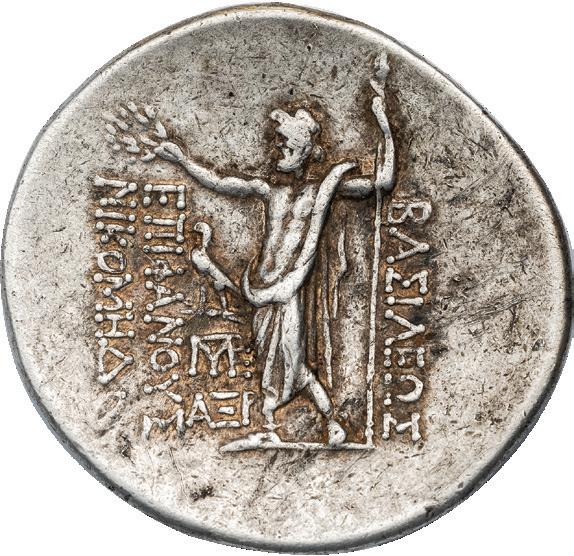
Obv. Diademed head of Nicomedes right. Rev. ΒΑΣΙΛΕΩΣ ΕΠΙΦΑΝΟΥΣ ΝΙΚΟΜΗΔΟΥ, Zeus standing left, crowning royal name and holding scepter, eagle on thunderbolt in inner left field with MYPE control monogram and AΞP (date), below.
DCA, Release 2, p. 314, giving a rarity of R3 (“1 or 2”); HGC 7, 642.
From the estate of Robert Haber, acquired mostly in the 1980s–early 2000s.
NGC graded XF, Strike 5/5, Surface 3/5, “light marks,” struck on a very broad, medallic planchet, an extremely rare date with one piece cited in market records. This seems to be only the third specimen that has appeared (the other two pieces are the Waddington coin cited in DCA and the market piece from CoinArchives), thereby confirming Cohen’s high rarity estimation. $ 2500
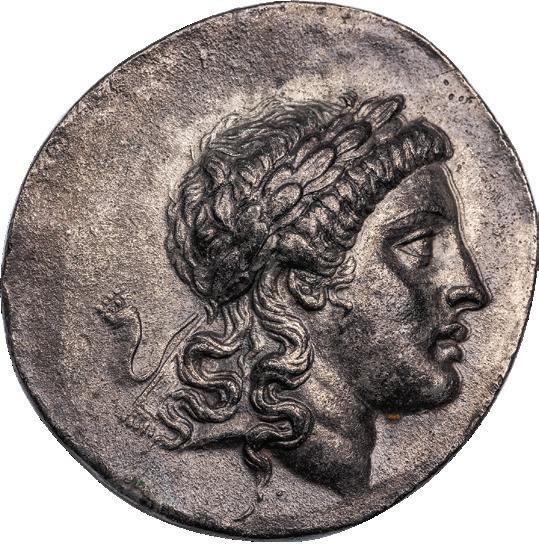

19189. AEOLIS. MYRINA. Ca. 155–145 BC.
Silver tetradrachm, 16.01 g, 36 mm.
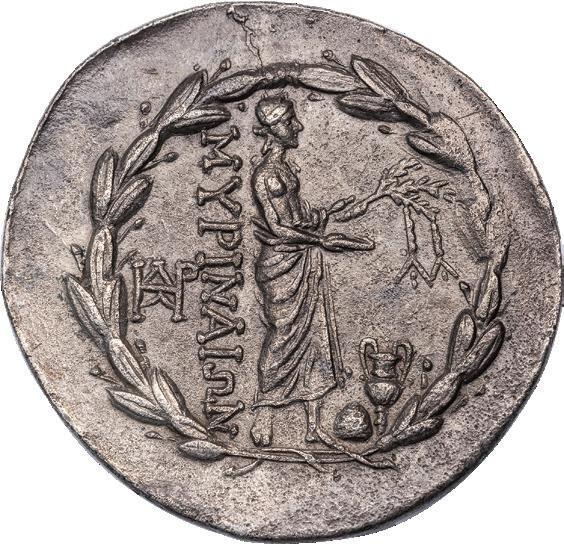
Obv. Laureate head of Apollo right. Rev. MΥΡINAIΩN, Apollo Gryneius right, standing, holding branch and phiale, omphalos and amphora at his feet, HPDL control monogram in left field, all within laurel wreath. Sacks, Issue 40, 70a (same obverse die).
From the estate of Robert Haber, acquired mostly in the 1980s–early 2000s.
NGC graded CHOICE AU, Strike 4/5, Surface 2/5, “edge bend,” a scarce emission struck on a large planchet, with dark gray find patina. $ 1250
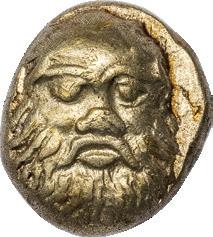


19351. IONIA. PHOCAEA. Ca. 477–388 BC.
Electrum hecte, 2.54 g, 10 mm.
Obv. Facing head of old Silenus wearing ivy wreath, seal at left (off flan). Rev. Quadripartite incuse square. Bodenstedt 67.
NGC graded CH XF, Strike 5/5, Surface 3/5, FINE STYLE, very nicely struck and attractive. $ 2500
15
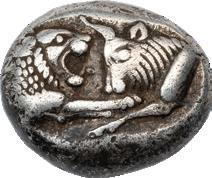
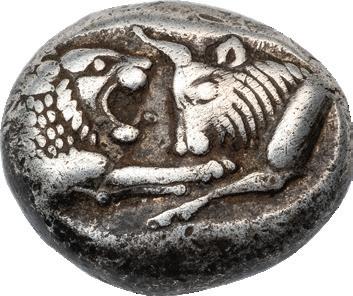
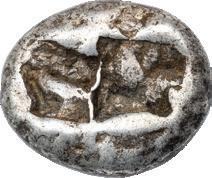
19211. LYDIA. CROESUS, 561–546 BC.
Siver siglos (half stater), 5.36 g, 15 mm.
Obv. Forepart of roaring lion right confronting forepart of bull left. Rev. Two incuse punches.
SNG Kayhan 1025; SNG von Aulock 2877; Berk, 100 Greatest Ancient Coins, 9.23.
NGC graded VF, Strike 5/5, Surface 4/5, very bold image with great centering.
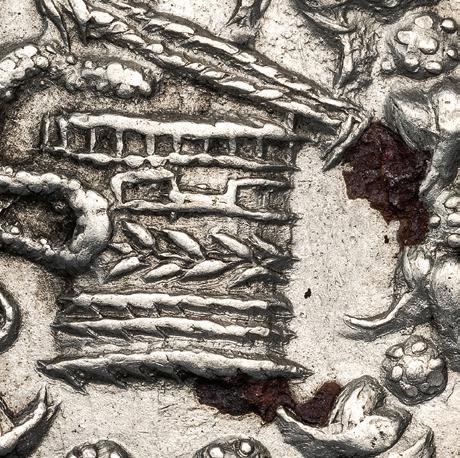
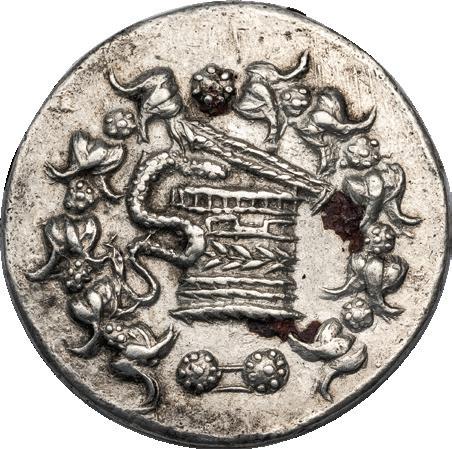
19083. LYDIA. TRALLES. Ca. 166–128 BC.
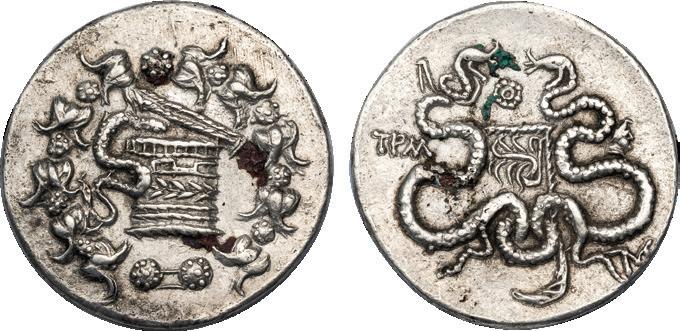
Plated (fourrée) cistophorus, 10.47 g, 28 mm. Imitative issue based on Tralles type ca. 140–135 BC.
$ 1250
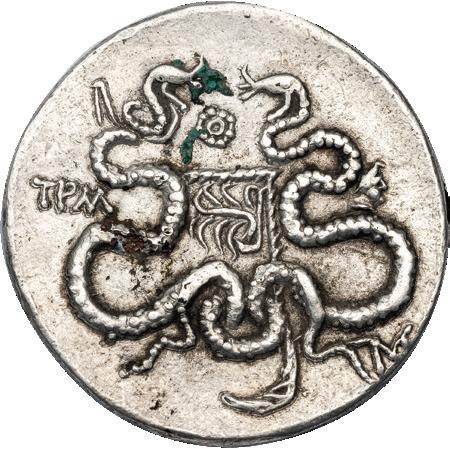
Obv. Cista mystica within ivy wreath. Rev. TPAΛ, snakes around bowcase, rosette above, small head of a god right in right field and M control in lower right.
Kleiner & Noe Series 39 var. (differences in symbols and control).
NGC graded AU, Strike 5/5, Surface 2/5, “core visible,” “ancient forgery,” “brushed,” parts of the core showing beneath the silver plating.
An extremely rare plated cistophoric specimen that closely imitates a Series 39 original. Although at first glance the coin looks official, there are minor differences – the star symbol of the original is transformed into a rosette or flower design, while the large head of Helios with its radiate crown is rendered in a very diminutive fashion lacking its crown; additionally, the fancy twisting pattern on the bowcase is oriented sideways, quite different from the original where it is vertical.
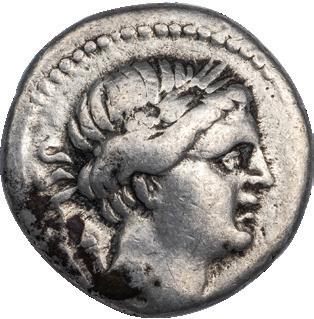
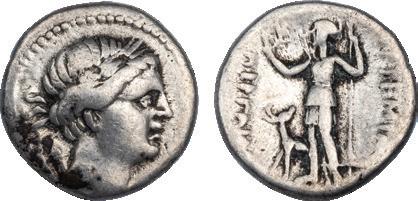
19011. PAMPHYLIA. PERGE. Ca. 260–230 BC
Silver drachm, 17 mm.
$ 750
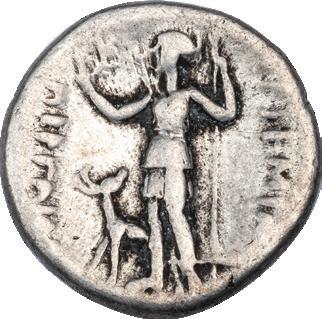
Obv. Head of Artemis right, bow and quiver behind. Rev. APTEMIΔOΣ ΠEPΓAIAΣ, Artemis standing left, stag standing left looking up at goddess.
Colin group 1.3, series 1 (dies V1.1/R1.1).
NGC graded CHOICE FINE, a very rare denomination for this series with only 11 specimens on CoinArchives. $ 475
16


19307. SELEUCID KINGDOM. SELEUCUS I, 312–281 BC.
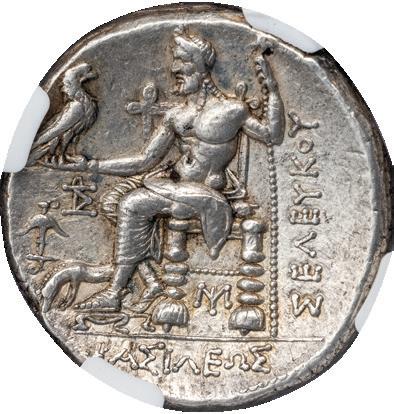
Silver tetradrachm, 16.98 g, 25 mm. Issue of Ecbatana using the types of Alexander III the Great, ca. 295 BC.
Obv. Head of young Heracles right in lion skin headdress. Rev. ΣEΛEYKOY BAΣIΛEΩΣ, Zeus enthroned left, holding eagle and scepter, ΗΔΣΩ control monogram above anchor and grazing horse in left field, MI control monogram under throne.
SC 204.4d; ESM 498; HGC 9, 12k.
NGC graded XF, Strike 3/5, Surface 4/5, a very rare variety with only 2 specimens in current market records. $ 750
IMITATIVE ISSUE OF UNCERTAIN MINT 6A PLATED IN TAYLOR’S DIE STUDY

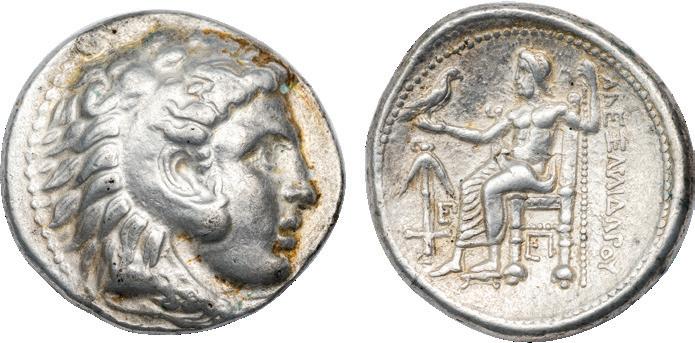
19284. SELEUCID KINGDOM. SELEUCUS I, 312–281 BC.
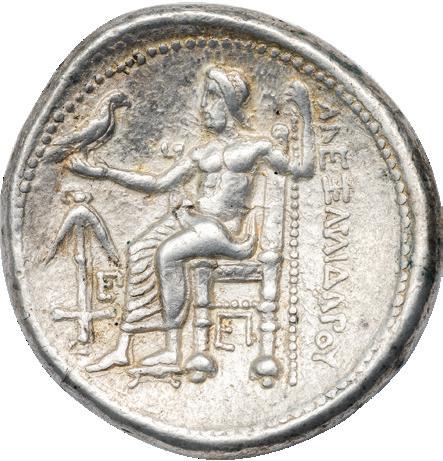
Silver imitative tetradrachm using the types of Alexander III the Great, 16.09 g, 29 mm. Issue of “Uncertain Mint 6A, in Babylonia,” ca. 311–305 BC.
Obv. Head of young Heracles right in lion skin headdress. Rev. ΛΛΕΞΛIΛIΔAΡΟΥ, Zeus enthroned left, holding eagle and scepter, anchor and ΕΠ control in left field, EI control below throne.
Published: Lloyd W. Taylor, “From Triparadeisos to Ipsos: Seleukos I Nikator’s Uncertain Mint 6A in Babylonia,” AJN 27 (2015), 107 (this coin listed and plated).
SC 67.4b; Price 3444 (as Marathus, following Newell).
Ex private collection, with a Spink ticket = VAuctions 242, 2/25/2010, lot 25.
NGC graded XF, Strike 5/5, Surface 4/5, extremely rare and interesting, apparently 1 of 2 specimens known (the other one is Taylor, 106, ex Hirsch 6/26/1967, lot 3120, struck from a different obverse but using the same reverse die). This variety has a style that is slightly off the norm but has been regarded by Newell, Price, SC and Lloyd as being a regular emission. However, none of these scholars have noted that the legend is severely garbled, the Greek letters are awkwardly engraved and betray the artist’s lack of knowledge of the language. This is typically an indication of an “imitative” issue, despite the otherwise pleasant style. $ 2500

19180. SELEUCID KINGDOM. ANTIOCHUS VII, 138–129 BC.
Silver tetradrachm, 16.18 g, 31 mm. Posthumous issue of the Cappadocian Kingdom. Obv. BAΣIΛEΩΣ ANTIOXOY EYEPΓETOY, diademed head of Antiochus VII right. Rev. Athena standing left, holding Nike extending wreath toward border, shield, and spear; ΔΙ monogram above A in left field, Φ in inner right field.
SC 2143.2 (citing 3 specimens in commerce); HGC 9, 1068.
From the estate of Robert Haber, acquired mostly in the 1980s–early 2000s; ex Franz Javorschek, Munich, with his old sales ticket. NGC graded CHOICE VF, Strike 5/5, Surface 3/5. $ 350
17
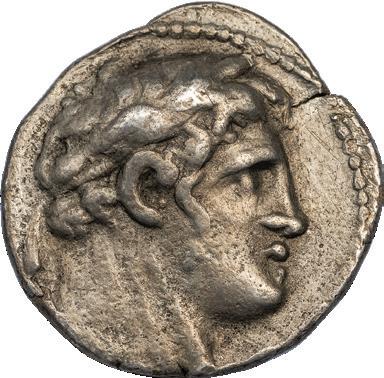
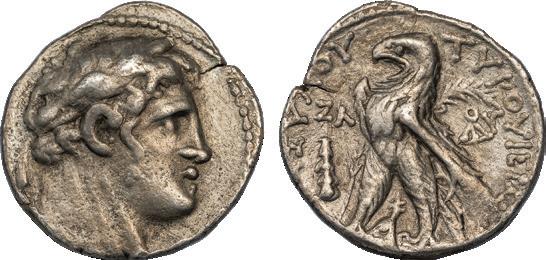
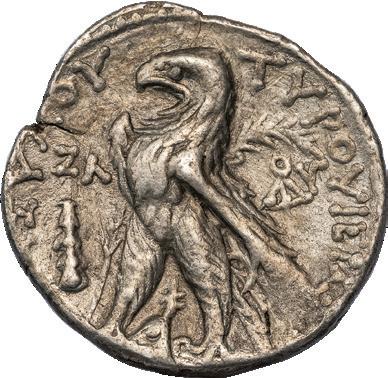
18036. PHOENICIA. TYRE.
Silver half shekel, 6.80 g, 22 mm. Issue of Tyre year 37 (90/89 BC).
Obv. Laureate head of Melkart right. Rev. TYPOY IEPAΣ KAI AΣYΛOY, eagle standing left on prow, ZΛ (date) above club in left field, DIOY control monogram in right field, Phoenician letter A between legs.
DCA Tyre Supplement Release 2, 762 (same dies).
NGC graded VF, Strike 4/5, Surface 2/5, “marks,” steel gray toning. $ 1650
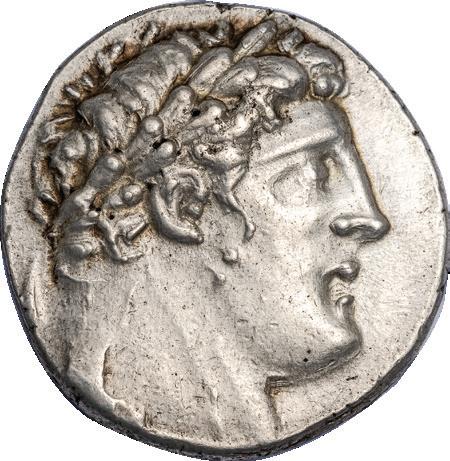
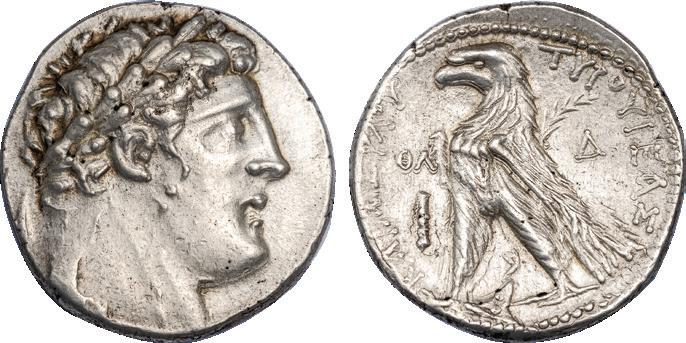
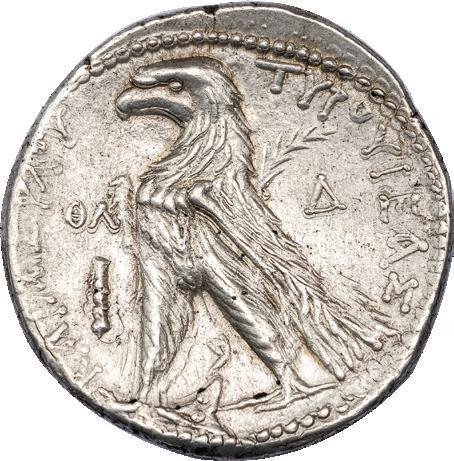
19329. PHOENICIA. TYRE.
Silver shekel, 14.35 g, 29 mm. Issue of Tyre year 39 (88/7 BC)
Obv. Laureate head of Melkart right. Rev. TYPOY IEPAΣ KAI AΣYΛOY, eagle standing left on prow, ΘΛ (date) above club in left field, Δ control monogram in right field, Phoenician letter B between legs.
DCA Tyre Supplement Release 2, 141 (same obverse die as 142).
NGC graded AU, Strike 4/5, Surface 2/5, “brushed.” $ 2750
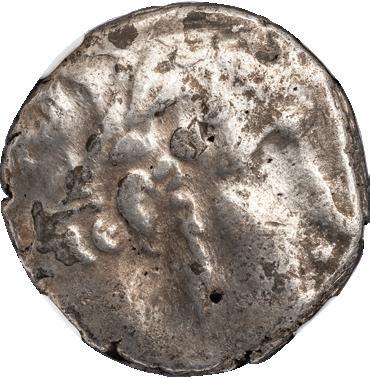
19297. PHOENICIA. TYRE.
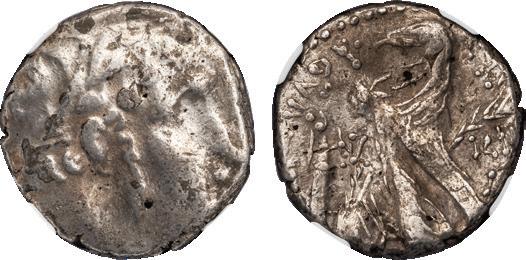
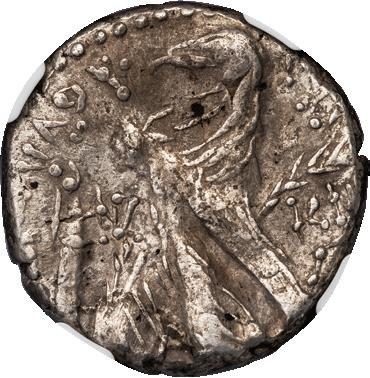
Silver shekel, 14.27 g, 22 mm. Issue of Tyre year 157 (AD 31/2), struck DURING THE LIFETIME OF CHRIST.
Obv. Laureate head of Melkart right. Rev. TYPOY IEPAΣ KAI AΣYΛOY, eagle standing left on prow, PNZ (date) above club in left field, KP above control monogram in right field, uncertain Phoenician letter between legs.
DCA Tyre Supplement Release 2, 565 (same obverse die).
Ex Stack’s Bowers, 10/22/ 2019, lot 71029.
NGC graded CHOICE VF, Strike 3/5, Surface 4/5, rare date with only 6 specimens appearing in market records; the date of the coin is about 1–2 years before the traditional date of Christ’s Crucifixion. $ 1950
18

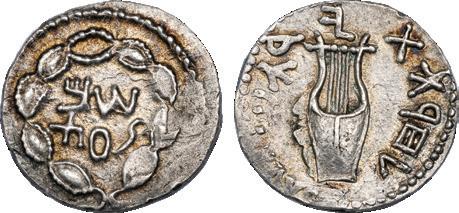
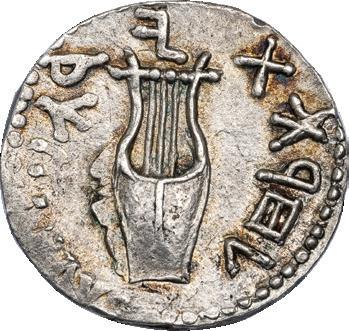
19352. JUDAEA. BAR KOKHBA REVOLT, 132–135 CE.
Silver zuz, 3.31 g, 18 mm. Undated issue of year 3 (CE 134/5).

Obv. [SIMON] within wreath of branches wrapped around eight almonds. Rev. [FOR THE FREEDOM OF JERUSALEM], lyre. Mildenberg 70 (O14/R42); Hendin 6th edition 6446.
NGC graded CHOICE AU, Strike 4/5, Surface 4/5, “overstruck” and “undertype: Vespasian” noted, iridescent highlights. The emperor’s profile is crystal clear on the reverse and part of the original legend (..AVG...) appears across from it by the rim. The placement of the legend and the type of imperial profile suggests that the undertype may be a denarius of the deified Vespasian, RIC II, 357. $ 3250

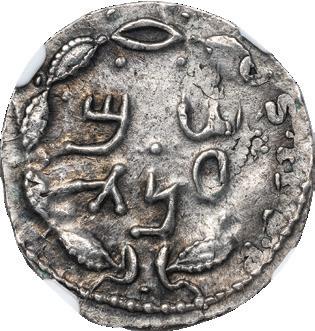
19418. JUDAEA. BAR KOKHBA REVOLT, 132–135 CE.
Silver zuz, 3.57 g, 18 mm. Undated issue of year 3 (CE 134/5).

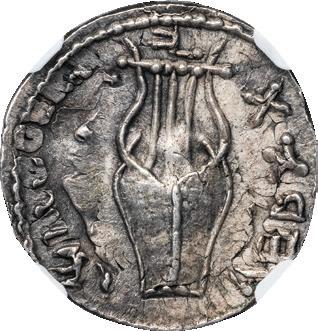
Obv. [SIMON] within wreath of branches wrapped around eight almonds. Rev. [FOR THE FREEDOM OF JERUSALEM], lyre. Mildenberg 130 (O19/R67); Hendin 6th edition 6456.
Ex Edward Waddell, inv. 56047, with his old ticket.
NGC graded AU, Strike 4/5, Surface 5/5, “overstruck” and “undertype: Trajan denarius” noted. The emperor’s entire head is visible on the reverse and part of the original legend (..AVG GER...) appears across from the face, by the rim. On the obverse, the Trajanic reverse is visible: the partial legend “...COS II P P ...” is seen near the rim on the right, and more towards the center of the coin appears part of the original type, a seated Abundentia holding her cornucopia. The Trajanic undertype is RIC II,1, the first RIC listed coin for Trajan from his initial COS II series dated AD 98–99. $ 2850
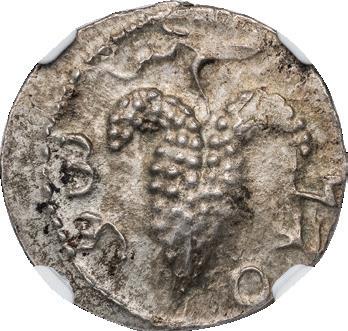

19419. JUDAEA. BAR KOKHBA REVOLT, 132–135 CE.
Silver zuz, 3.53 g, 18 mm. Undated issue of year 3 (CE 134/5).
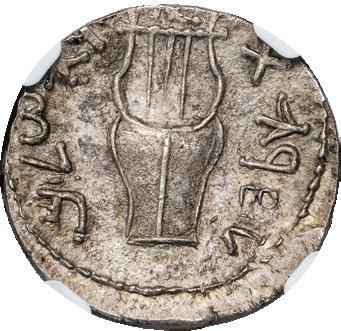
Obv. [SIMON], grapes hanging from branch. Rev. [FOR THE FREEDOM OF JERUSALEM], lyre. Mildenberg 213 (O24/R137); Hendin 6th edition 6462.
NGC graded CHOICE AU, Strike 4/5, Surface 4/5, with no traces of the undertype visible. $ 2500
19
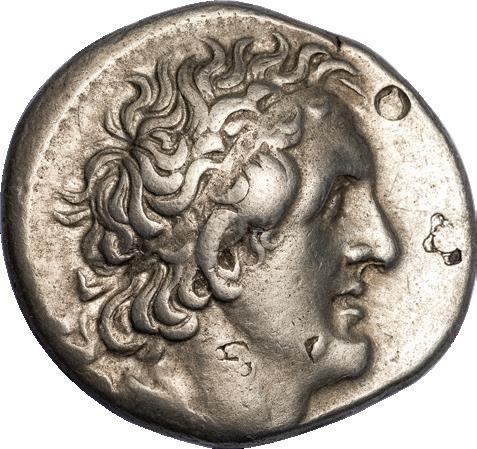

19338. EGYPT. PTOLEMAIC KINGS. PTOLEMY I. 305–282 BC.
Silver tetradrachm, 14.03 g, 28 mm. Issue of Alexandria, beginning ca. 294 BC.

Obv. BAΣIΛEΩΣ ΠTOΛEMAIOY, diademed head of Ptolemy I right, wearing aegis around neck, small Δ behind ear. Rev. Eagle standing left on thunderbolt, P above XAP monogram in left field.
CPE 142; Svoronos 265; SNG Copenhagen 73.
NGC Graded CHOICE VF, Strike 5/5, Surface 2/5, “countermarks,” “test marks,” “graffito.”
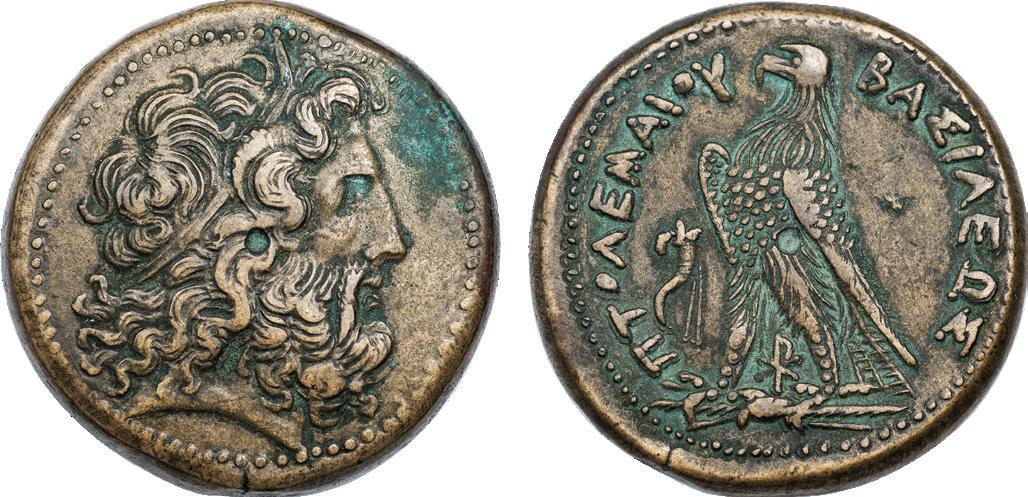
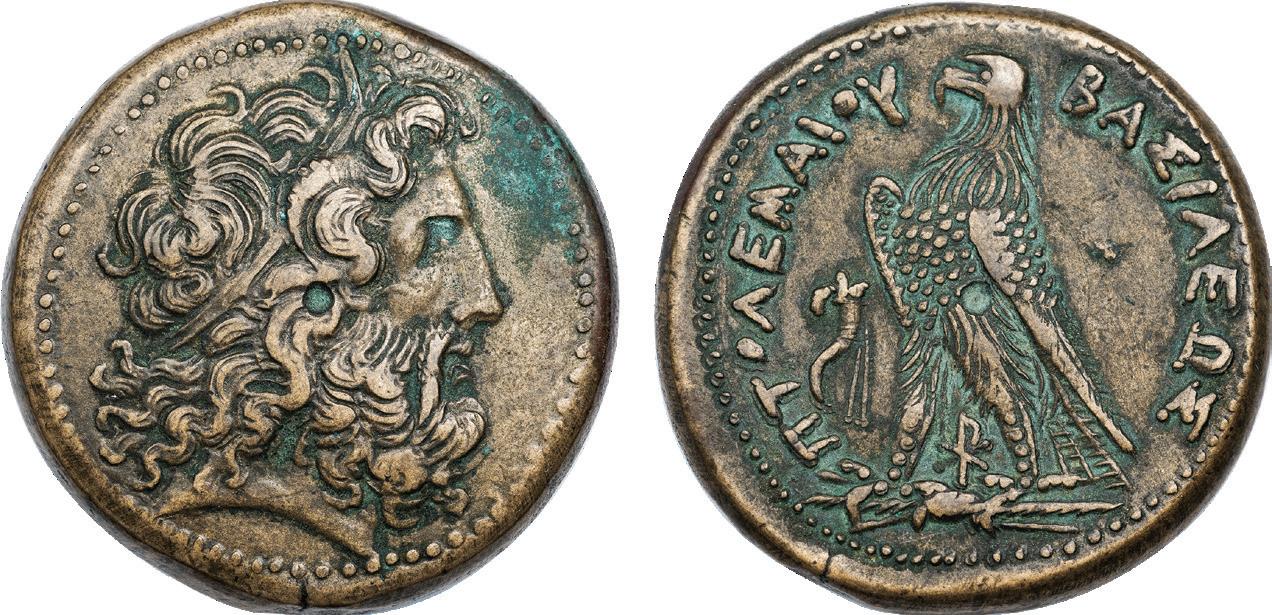
19204. PTOLEMAIC KINGDOM. PTOLEMY III, 246–222 BC.
Bronze AE43, 69.27 g, 42 mm. Issue of Alexandria.
$ 800

Obv. Diademed head of Zeus Ammon right. Rev. ΠTOΛEMAIOY BAΣIΛEΩΣ, eagle with folded wings standing left on thunderbolt, looking right, filleted cornucopia in left field, XP control between eagle’s legs.
CPE B395; Svoronos 964; SNG Copenhagen 171–172.
NGC graded XF STAR, Strike 5/5, Surface 4/5, a remarkable specimen.
The control on this extremely large bronze issue of Ptolemy, the largest module struck, is interesting from many points of view. Lorber, in her CPE, notes the fine style of these coins, part of her Series 5B. The control resembles the Christian chi–rho, the monogram of Christ, but this is pure coincidence. In fact, the noted Greek scholar Svoronos, who compiled the first catalogue of Ptolemaic coinage, associated the monogram with the Greek exile Chremonides. Svoronos believed that the Athenian was the admiral in charge of the Ptolemaic fleet during the Third Syrian War and these bronzes were struck by him to support the war effort. Although not universally accepted, the association with Chremonides remains a possibility. $ 2500
20

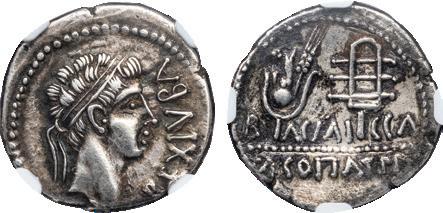
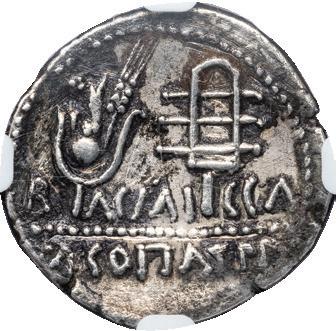
19224. KINGDOM OF MAURETANIA. JUBA II & CLEOPATRA SELENE, 25 BC–AD 23/24.
Silver denarius, 2.79 g, 18 mm. Issue of Caesarea, Mauretania.
Obv. REX IVBA, diademed head of Juba II right. Rev. BACIΛICCA KΛЄΟΠΑΤΡA, Isis Headdress with grain stalk and sistrum. Mazard 301.
NGC graded XF, Strike 5/5, Surface 2/5, “scratches.”
An historic coin struck in the name of Cleopatra Selene, the daughter of Cleopatra VII and Marc Antony. She was the most successful of Cleopatra’s offspring as evidenced by her integration into the Roman system and subsequent role as queen of Mauretania alongside her husband Juba II. $ 850
DENARIUS OF JUBA II WITH HIS SON PTOLEMY PLATED IN SPOERRI–BUTCHER
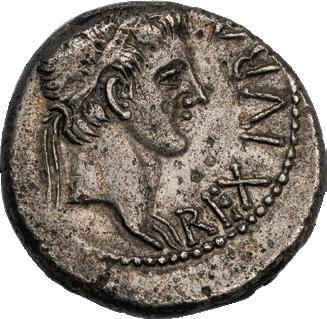
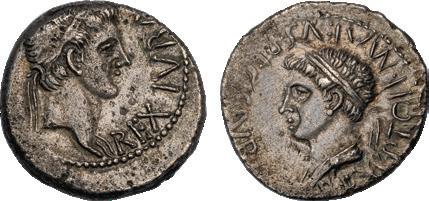
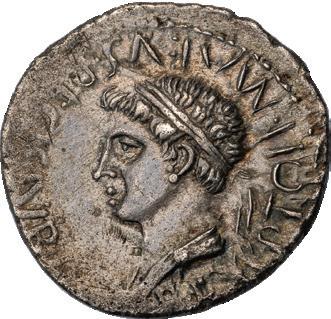
19107. KINGDOM OF MAURETANIA. JUBA II & PTOLEMY, 25 BC–AD 24.
Silver denarius, 3.37 g, 17 mm. Issue of Caesarea, Mauretania.
Obv. REX IVBA, diademed head of Juba II right. Rev. REX PTOLEMAEVS REGIS IVBAE F, youthful draped and diademed bust of Ptolemy left.
Mazard 379; M. Spoerri–Butcher. “Juba II de Maurétanie (25 a.C.–24 p.C.). Quelques réflexions concernant le classement du numéraire d’argent non daté” in Mélanges Amandry, Group B, dies A13/R5, 26 (this coin listed and illustrated).
Ex Gorny & Mosch 134, 10/11/2004, lot 1757.
NGC graded CHOCE XF, Strike 3/5, Surface 3/5, “brushed,” a coin depicting Cleopatra VII’s grandson and the last member of the Ptolemaic line. Ptolemy was the son of Cleopatra Selene and Juba of Mauretania and here he is proclaimed “king” alongside his father. His portrait on this coin is of exceptional quality, quite different from the stylized images often seen for this series. $ 2350
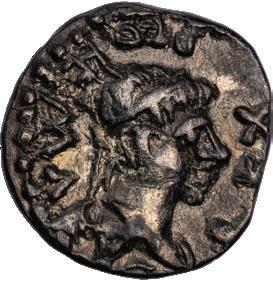

18899. KINGDOM OF MAURETANIA. PTOLEMY, ca. AD 21–40.

Silver denarius, 1.86 g, 14 mm. Issue of Caesarea, Mauretania, dated year 7 or 8 or 9 (AD 28–30).
Obv. REX PTOLEMAE[VS], diademed and draped bust of Ptolemy right. Rev. R A VII…[?], Capricorn right. Mazard 454–456.
NGC graded XF, Strike 4/5, Surface 3/5, rare variety. The regnal date is slightly off planchet, so the date may be either year VII, VII[I], or VII[II]. The Capricorn makes reference to the birth sign of Augustus, enabling Juba to suggest a connection with the great Roman emperor. $ 1350
21
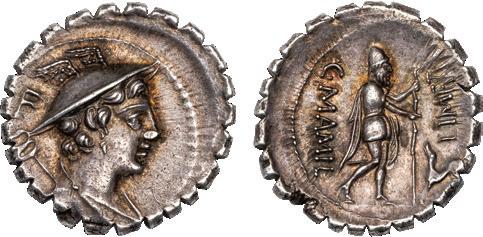

19381. C. MAMILIUS LIMETANUS, 82 BC.
Silver serrate denarius, 3.94 g, 20 mm. Issue of Rome.
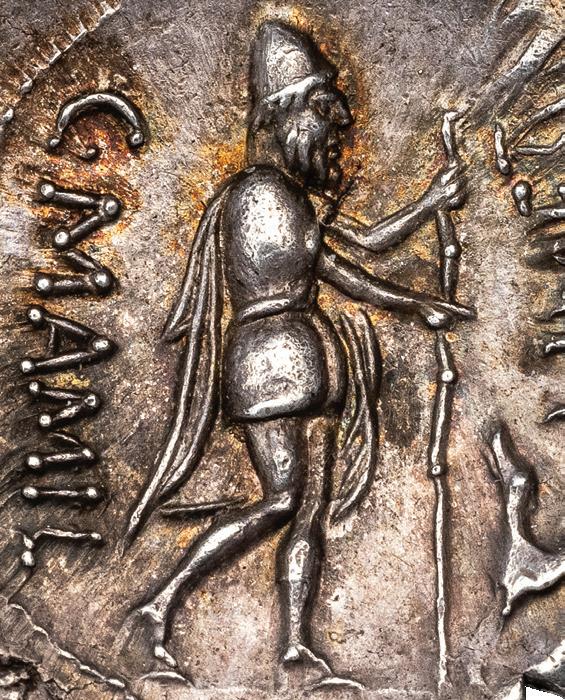
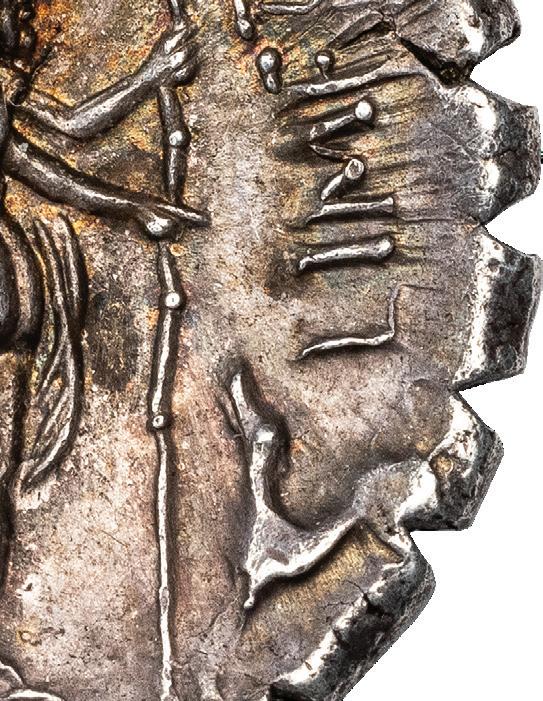
Obv. Draped bust of Mercury right, wearing petasus and holding caduceus. Rev. C MAMIL LIMET[AN], Ulysses (Odysseus) greeting his dog Argos who looks up and wags his tail in recognition.
Crawford 362/1; Sydenham 741.
Ex Bob Guynn collection, purchased from Ed Waddell.
NGC graded AU, Strike 4/5, Surface 5/5, glossy steel–gray patination with iridescent highlights.
The reverse type recounts the episode in Homer’s Odyssey 17.290 ff, when a disguised Odysseus, home after the Trojan War, is recognized by his faithful dog Argos:
“[290] Thus they spoke to one another. And a hound that lay there raised his head and pricked up his ears, Argos, the hound of Odysseus, of the steadfast heart…yet even now, when he marked Odysseus standing near, he wagged his tail and dropped both his ears, but nearer to his master he had no longer strength to move. Then Odysseus looked aside and wiped away a tear… [324] So saying, (Odysseus) entered the stately house … But as for Argos, the fate of black death seized him straightway when he had seen Odysseus in the twentieth year...” (Odyssey 17.290 ff in the A.T. Murray translation). $ 3500
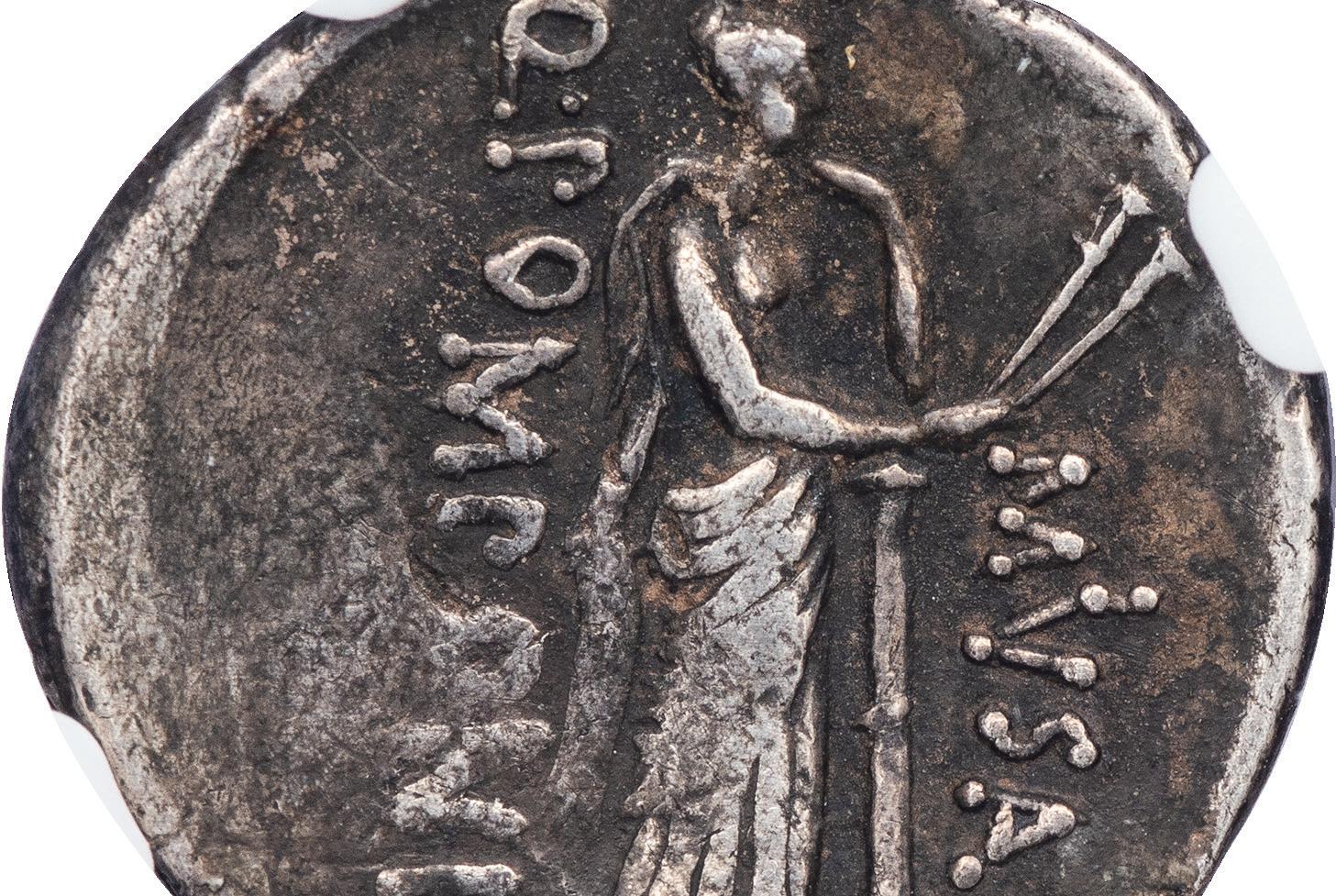
15480. ROMAN REPUBLIC. Q. POMPONIUS MUSA, 66/56 BC.
Silver denarius, 3.74 g, 18 mm.
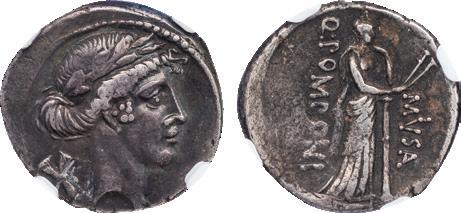
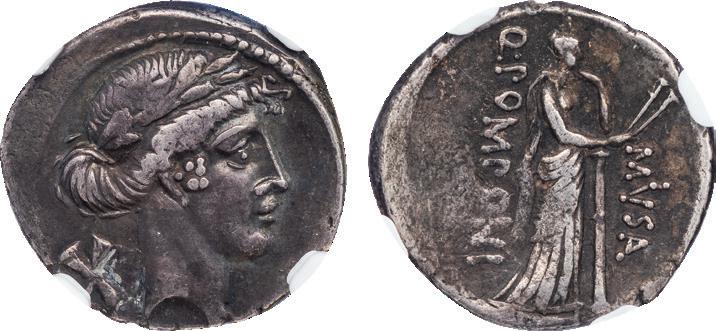
Obv. Laureate head of Apollo right, two crossed flutes in left field. Rev. Q POMPONI MVSA, Euterpe, the Muse of Lyric Poetry, standing left and leaning on a column, holding two flutes.
Crawford 410/5; Sydenham 815.
Ex Phil Peck/Morris Collection.
NGC graded CHOICE VF, Strike 4/5, Surface 4/5, dark cabinet toning, part of Pomponius Musa’s “Muse series,” a choice of subject matter based on the moneyer’s name. $ 750
22
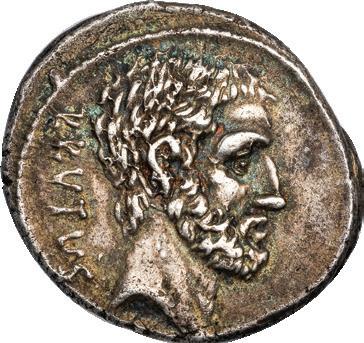
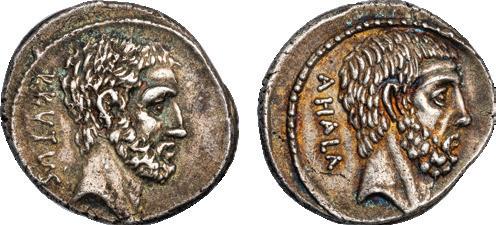
19108. ROMAN IMPERATORIAL. M. JUNIUS BRUTUS, d. 42 BC.

Silver denarius, 4.01 g, 19 mm. Issue of Rome struck by Brutus while he served as moneyer, 54 BC.
Obv. BRVTVS, head of L. Junius Brutus right, within dotted circle. Rev. AHALA, head of C. Servilius Ahala right.
Crawford 433/2; Sydenham 907.
NGC graded CHOICE XF, Strike 5/5, Surface 4/5, attractive portraits on a coin of good metal with iridescent highlights.
A historical coin on so many levels, this is part of an emission struck by the famous Brutus, Caesar’s assassin, a decade earlier when he served as moneyer. The portraits on the coin make reference to his family’s proud history of service to the Republic as they illustrate L. Junius Brutus and C. Servilius Ahala. L. Junius Brutus was the man who banished the Tarquin kings and established the Republic while Ahala, a descendant on his mother’s side, was responsible for killing another politician who aspired to kingship. The coin, with its overwhelming pro–Republican sentiment, anticipates M. Junius Brutus’ role in the murder of Caesar. $ 2250

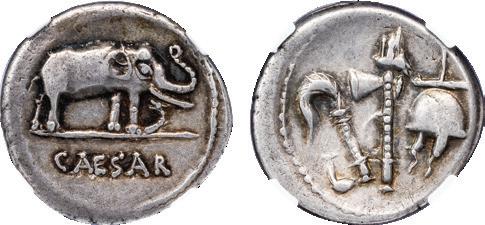
19044. ROMAN IMPERATORIAL. JULIUS CAESAR, d. 44 BC.
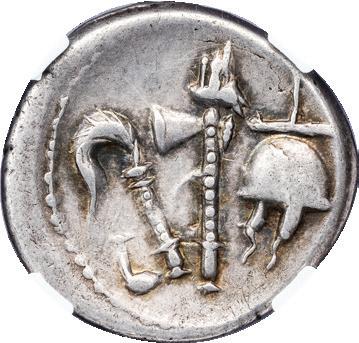
Silver denarius, 3.67 g, 19 mm. Issue of a military mint traveling with Caesar, 49–48 BC.
Obv. CAESAR, elephant to right, trampling a serpent. Rev. Official instruments of the Pontifex Maximus – simpulum, aspergillum, securis and apex.
Crawford, 443/1; Sydenham, 1006.
Ex Noonans 137, 9/21/2016, lot 1767.
NGC graded CHOICE VF, Strike 5/5, Surface 4/5. $ 2500
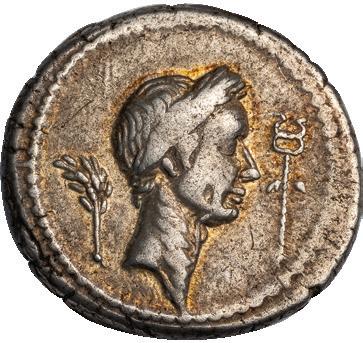

19238. ROMAN IMPERATORIAL. JULIUS CAESAR, d. 44 BC.

Silver denarius, 3.85 g, 19 mm. Posthumous issue struck by L. Livineius Regulus at Rome, 42 BC.
Obv. Laureate head of Caesar right, laurel branch to left, winged caduceus at right. Rev. L LIVINEIVS REGVLVS, bull charging right. Crawford 494/24; Sydenham 1106.
NGC graded CHOICE VF, Strike 4/5, Surface 5/5, the depiction of Julius Caesar showing aspects of “verism” (hyper realism), a feature characteristic of late Republican portraiture. $ 3950
23
THE GREAT COMET OF 44 BC
In the summer of 44 BC a large comet appeared in the sky and was documented both in Europe and China. It may have been the brightest comet during daytime in recorded history and is consequently known as the “Great Comet of 44 BC.” Octavian interpreted the comet as a sign confirming the transition of Caesar’s spirit to the divine sphere, proclaiming it to be the sidus Iulium (“Caesar’s star”). In his Metamorphoses XV, 745–842, the poet Ovid rhapsodized the comet: “Jupiter hardly had pronounced these words, when kindly Venus, although seen by none, stood in the middle of the Senate–house, and caught from the dying limbs and trunk of her own Caesar his departing soul. She did not give it time so that it could dissolve in air, but bore it quickly up, toward all the stars of heaven; and on the way, she saw it gleam and blaze and set it free. Above the moon it mounted into heaven, leaving behind a long and fiery trail, and as a star it glittered in the sky…” (Brookes More translation, 1922).
Immediately after this event a number of stellar objects begin to appear on Roman Imperatorial coins of both Marc Antony, the leader of the Caesarean faction, and Octavian (Augustus after 27 BC), Caesar’s adoptive heir. These objects are commonly described simply as “stars,” but considering the events of 44 BC and the identity of the issuers, it is far more likely that the comet is being illustrated throughout and expertly woven into the numismatic narrative and iconography of the Roman world. This development culminates in the famous “comet denarius” of Augustus, which explicitly associates the comet with Caesar’s deification by juxtaposing it with the legend divus Iulius (“the divine Julius”).

19065. ROMAN IMPERATORIAL. MARC ANTONY AND OCTAVIAN.
Silver denarius, 3.82 g, 19 mm. Issue of a mint in central or southern Italy, ca. late 40–early 39 BC.
Obv. M ANTON IMP III VIR R P C, bare head of Marc Antony right, comet below neck truncation. Rev. CAESAR IMP III VIR R P C, bare head of Octavian right, wearing a slight beard, pellet below neck.
Crawford 528/2a; Sydenham 1193.
NGC graded CHOICE VF, Strike 5/5, Surface 5/5. The comet’s presence here suggests that both men are Caesar’s designated heirs. $ 4000

19031. ROMAN IMPERATORIAL. OCTAVIAN (AUGUSTUS), 27 BC–14 AD.
Silver denarius, 3.52 g, 20 mm. Issue of an Italian mint, ca. 32–31 BC.
Obv. Head of Augustus right. Rev. CAESAR DIVI F, Venus to right, seen from the back, holding helmet and scepter and leaning on column to her left; shield with comet at lower left, propped against column.
RIC I 250a.
NGC graded VF, Strike 5/5, Surface 4/5, a scarce denarius variety on which Octavian proclaims himself to be the “son of the divine Julius” and depicts Venus, the divine progenitor of the Julian clan on the reverse. The goddess gazes at the helmet of her lover Mars, who was considered to have aided Octavian at the battle of Philippi, while his shield bears a stellar symbol, almost certainly the comet (sidus Iulium) symbolizing the deification of Caesar, Octavian’s adoptive father.
Paul Zanker, in his book The Power of Images in the Age of Augustus, illustrates this type of denarius twice (figs. 27c and 41b) and comments on the importance of the coin: “His protectress is Venus Genetrix...who regards the arms of Mars, with the sidus Iulium blazing on the shield” (p. 53). $ 3500
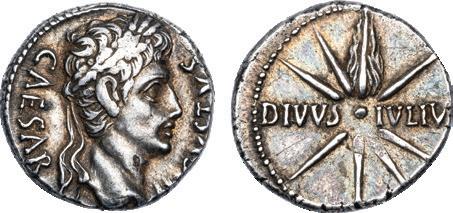
19111. ROMAN EMPIRE. AUGUSTUS, 27 BC–AD 14.
Silver denarius, 3.96 g, 18 mm. Issue of a mint in Spain (perhaps Colonia Caesaraugusta), ca. 19–18 BC. Obv. CAESAR AVGVSTVS, head of Augustus right, wearing the oak crown (corona civica). Rev. DIVVS IVLIV[S], comet with tail upward.
RIC I 102.
Ex Áureo & Calicó 367, 6/2/2021, lot 2068.
NGC graded CHOICE VF, Strike 4/5, Surface 4/5. This historic type depicts the Great Comet of 44 BC, here clearly associated with the deification of Julius Caesar. $ 3500
24


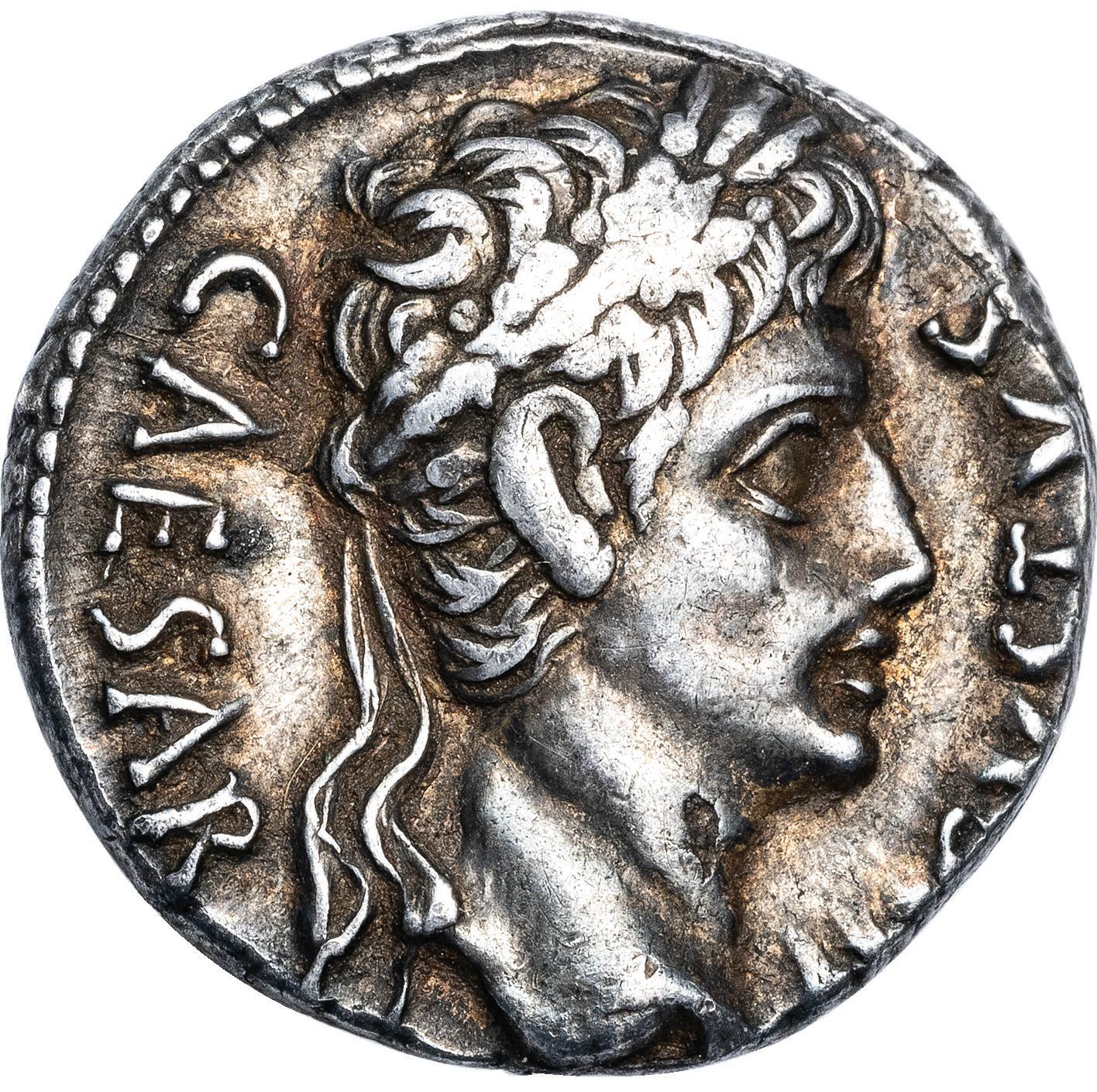
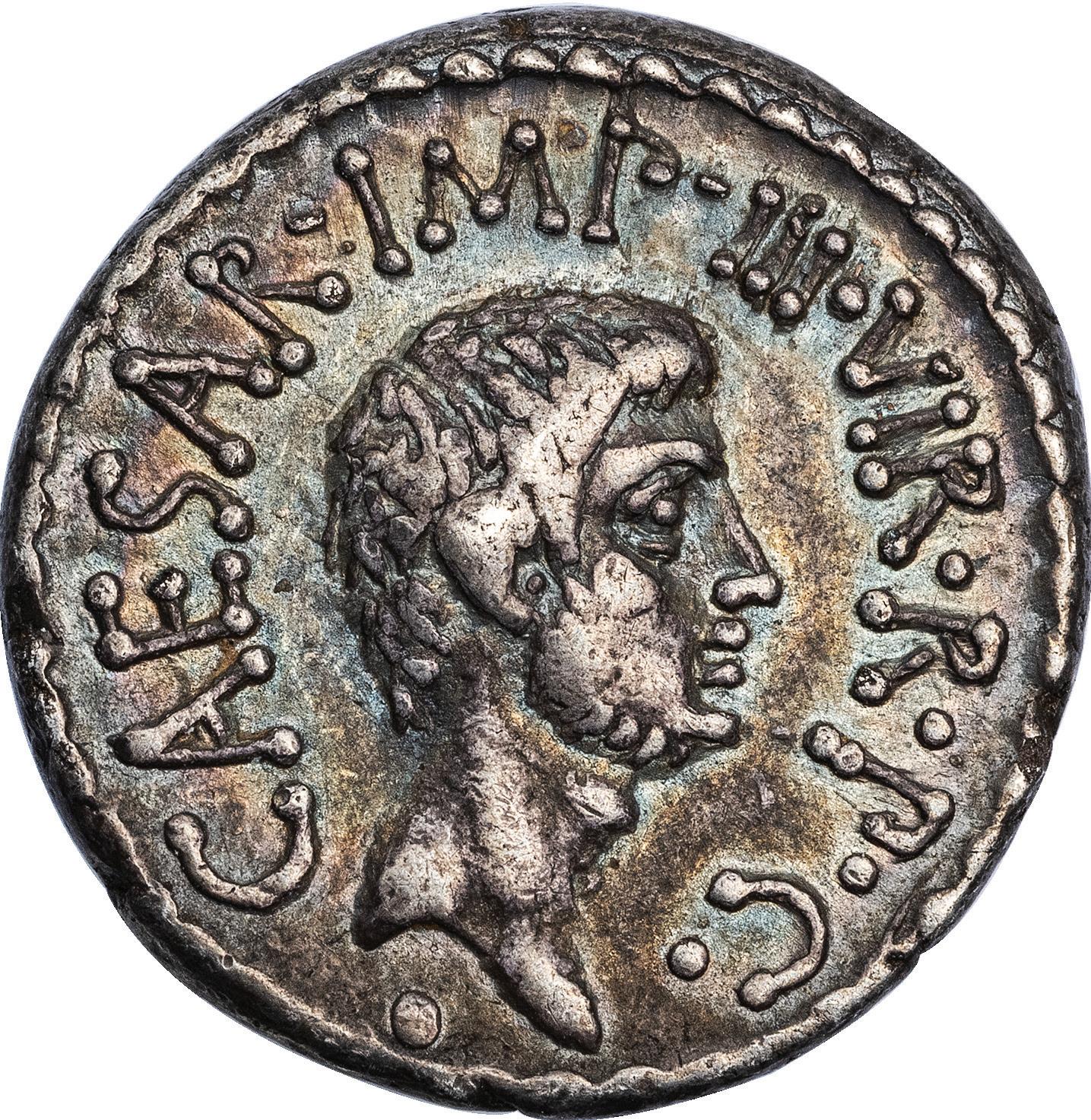

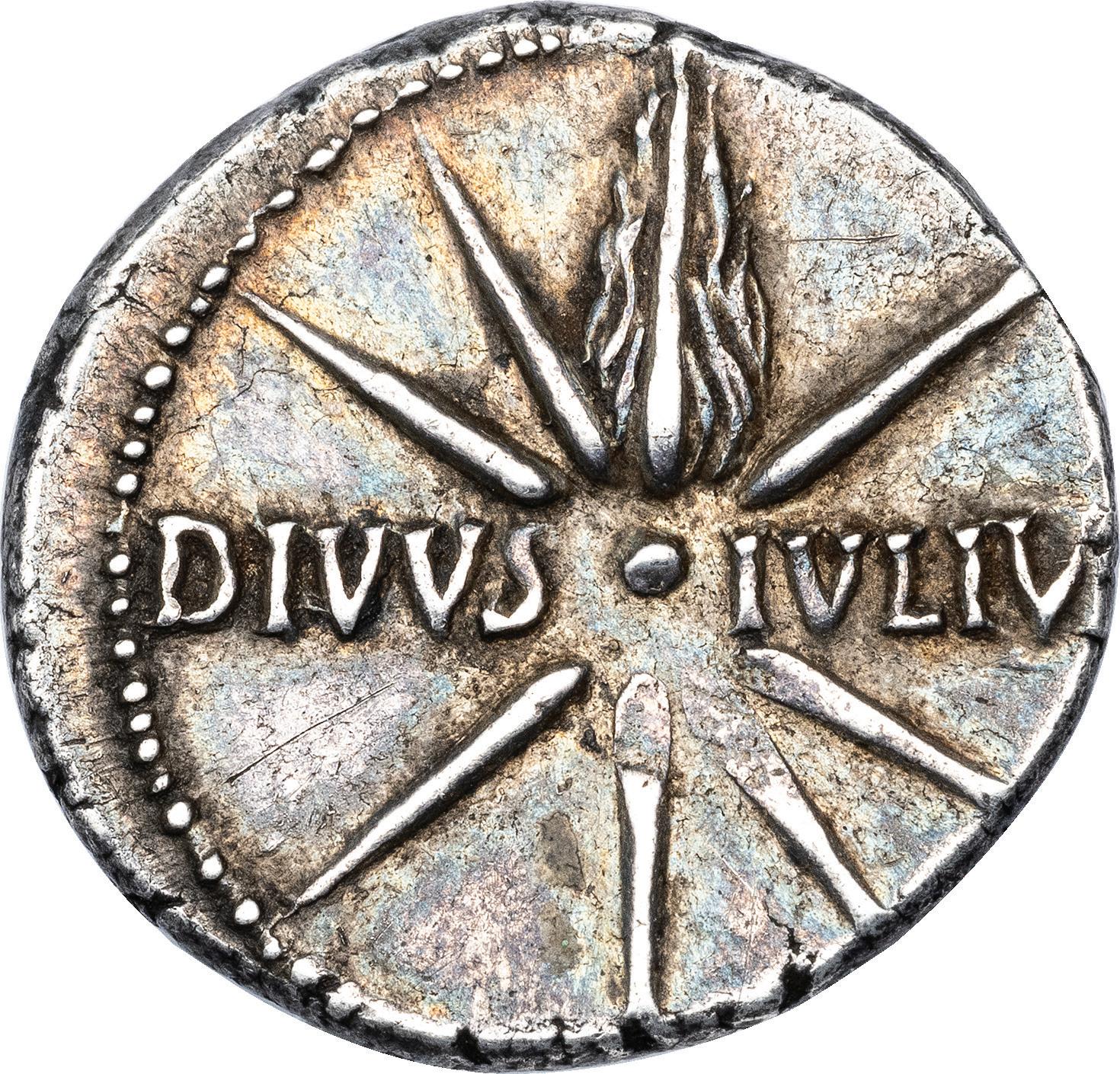
25


17554. ROMAN EMPIRE. TIBERIUS, AD 14–37.
Silver denarius, 3.82 g, 18 mm. Issue of Lugdunum (Lyon).
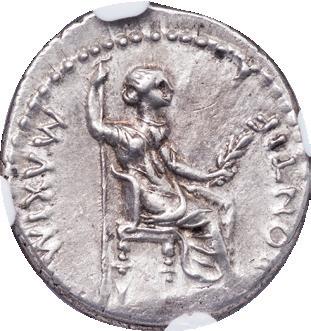
Obv. TI CAESAR DIVI AVG F AVGVSTVS, laureate head of Tiberius right. Rev. PONTIF MAXIM, female figure (Livia as Pax) enthroned right, holding scepter and olive branch.
RIC I 30.
NGC graded CHOICE AU, Strike 3/5, Surface 3/5, “brushed.” This is a high-grade example of a famous historical coin commonly regarded as the “tribute penny” mentioned in the New Testament, Matthew 22:19 ff, when Christ addresses his followers: “‘Show Me the coin used for the poll–tax.’ And they brought Him a denarius. And He said to them, ‘Whose likeness and inscription is this?’ They said to Him, ‘Caesar’s.’ Then He said to them, ‘Then render to Caesar the things that are Caesar’s; and to God the things that are God’s.’ And hearing this, they were amazed, and leaving Him, they went away.”
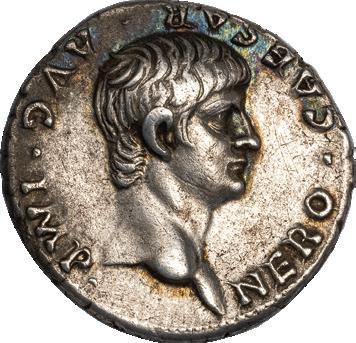
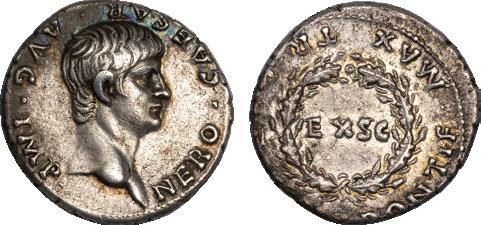
19366. ROMAN EMPIRE. NERO, AD 54–68.
Silver denarius, 3.57 g, 19 mm. Issue of Lugdunum (Lyon), AD 58–59.
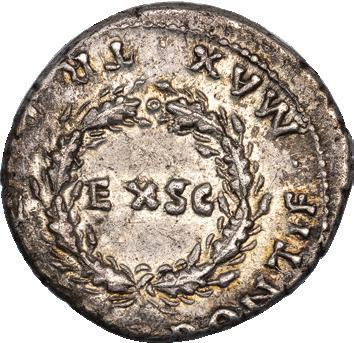
$ 2500
Obv. NERO CAESAR AVG IMP, youthful head of Nero right. Rev. PONTIF MAX TR P [V P P], EX S C within oak wreath (corona civica).
RIC I 17 (R2).
NGC graded CHOICE XF, Strike 4/5, Surface 3/5, “brushed,” lustrous, with areas of blue iridescence on the obverse and a well realized portrait of the young emperor. $ 4800
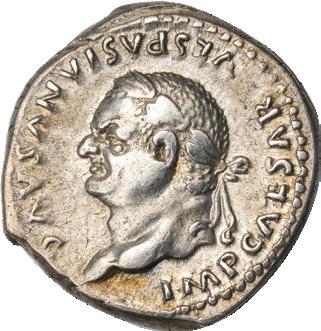

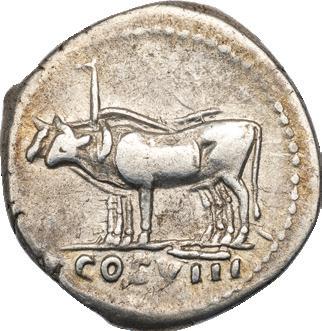
19233. ROMAN EMPIRE. VESPASIAN, AD 69–79.
Silver denarius, 3.40 g, 18 mm. Issue of Rome, AD 77–78.
Obv. VESPASIANVS AVG IMP CAESAR, laureate head of Vespasian left. Rev. COS VIII, pair of yoked oxen left. RIC II.1 944.
NGC graded CHOICE VF, Strike 5/5, Surface 4/5, scarcer with the left–facing portrait. $ 675
26
RARE TRAJAN DENARIUS VARIANT PUBLISHED AND PLATED BY WOYTEK
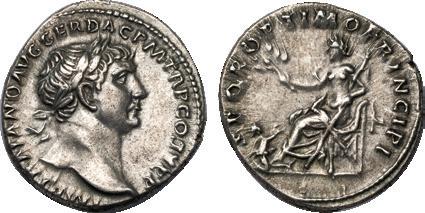
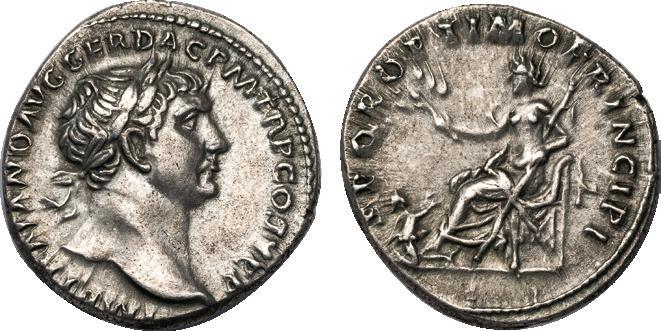
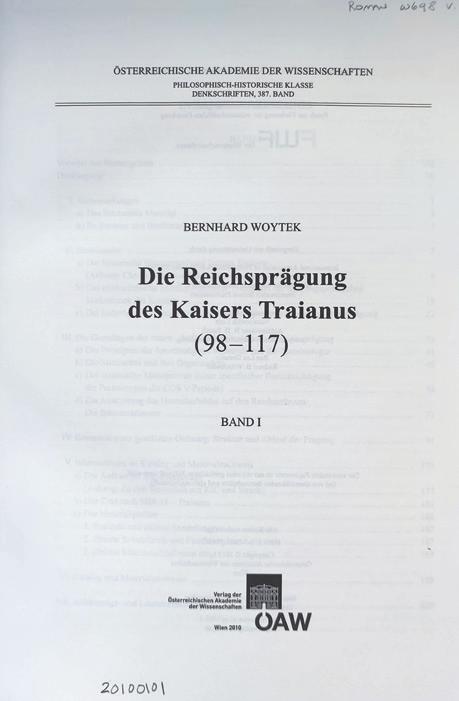
19085. ROMAN EMPIRE. TRAJAN, AD 98–117.
Silver denarius, 3.42 g, 18 mm. Issue of Rome, ca. AD 106–107.

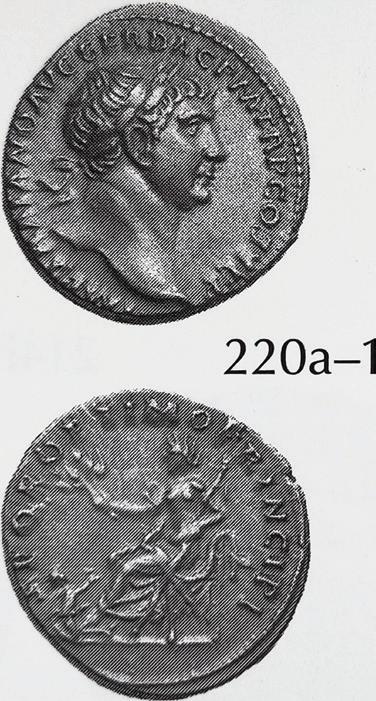
Obv. IMP TRAIANO AVG GER DAC P M TR P COS V P P, laureate bust of Trajan right. Rev. S P Q R OPTIMO PRINCIPI, Pax enthroned left, holding palm branch and scepter, Dacian in submission at left.
RIC II.1, 187–189 var.; Woytek 220a (this coin listed and plated).
Ex Harlan J. Berk 150, 8/8/2006, lot 405.
NGC graded CHOICE XF, Strike 4/5, Surface 4/5, extremely rare variant with this portrait type, Woytek listing only 4 specimens including the present piece. $ 850
IMPRESSIVE HADRIANIC OVERSTRIKE ON A CISTOPHORUS OF AUGUSTUS
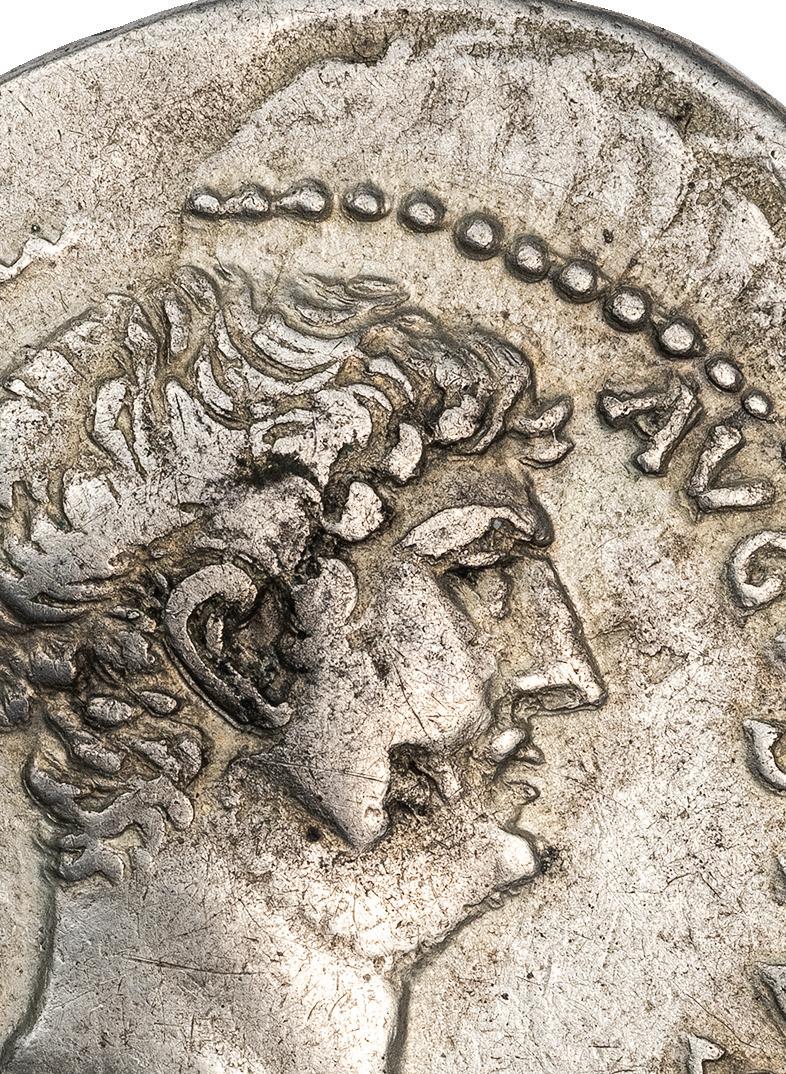
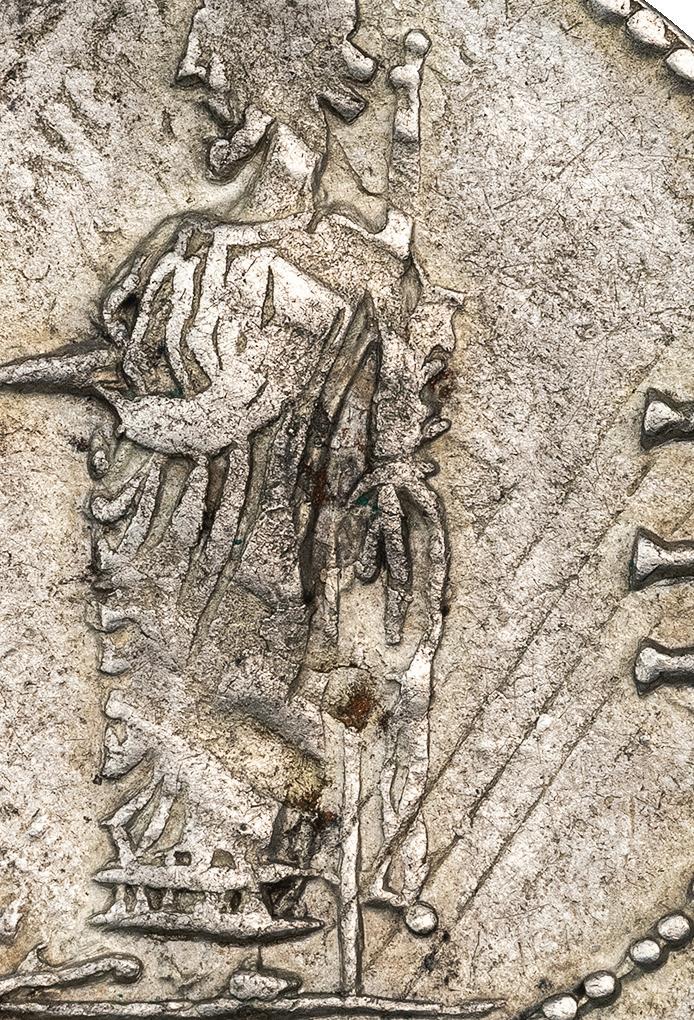
19145. ROMAN EMPIRE. HADRIAN, 117–138 AD.
Silver cistophorus, 11.14 g, 27 mm. Issue of Laodicea ad Lycum.

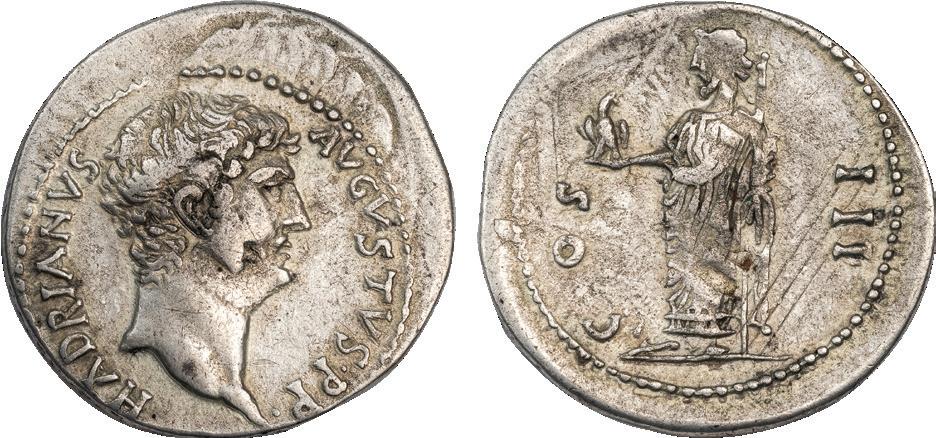
Obv. HADRIANVS AVGVSTVS P P, bare head of Hadrian right. Rev. COS III, Zeus Laodiceus standing left, holding eagle. Metcalf, Cistophori, 56 (lists 26 specimens).
NGC graded CHOICE VF, Strike 3/5, Surface 4/5, “overstruck on Augustus.” The coin is overstruck on a cistophorus of Augustus depicting the Temple of Roma and Augustus (perhaps RPC 2217 or 2219), as shown by the visible parts of the structure on the coin’s reverse. Similarly, on the obverse, traces of Augustus’ head are clearly visible at the top. $ 1250
27
SUPERB SLIGHTLY ROTATED DOUBLE STRIKE ERROR

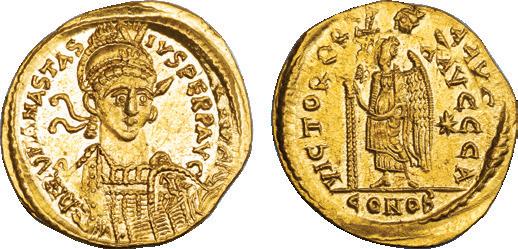

17764. BYZANTINE EMPIRE. ANASTASIUS I, AD 491–518.
Gold solidus, 4.47 g, 21 mm. Issue of Constantinople, officina A, ca. AD 492–507.
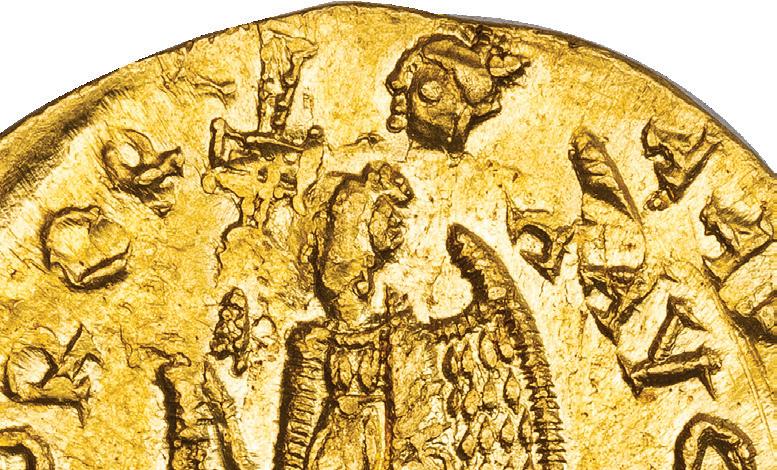
Obv. D N ANASTAS IVS PERP AVG A, helmeted and cuirassed bust of Anastasius three quarters right, holding spear and shield with horseman device. Rev. VICTORIA AVGGG, Victory holding jeweled cross, star in right field, CONOB in exergue.
Sear 3.
NGC graded MINT STATE, Strike 3/5, Surface 4/5, “double struck” and “scratch,” an interesting ancient ERROR coin, with what amounts to two heads for the Victory on the reverse resulting from the slightly rotated double strike.


19441. BYZANTINE EMPIRE. JUSTIN I, AD 518–527.

Gold solidus, 4.32 g, 20 mm. Issue of Constantinople, officina S, minted AD 522–527.
$ 2500
Obv. D N IVSTINVS P P AVC, helmeted and cuirassed bust of Justin slightly right, holding spear and shield with horseman device. Rev. VICTORIA AVCC S, Angel standing, facing, holding long cross and globus cruciger, star at right, CONOB in exergue.
Sear 56.
NGC graded MINT STATE, Strike 5/5, Surface 2/5, “clipped.”
This issue of Justin is the first time an angel appears on coinage. The Christian angel replaces Victory, a distinctly pagan goddess, on the reverse of Byzantine coins in the latter part of Justin’s reign although the legend, VICTORIA AVGG, remains the same. From the beginning there is an apparent attempt of show the angel as a sexless being, with a curious closely cropped hairdo and puppet–like features, but otherwise it continues to resemble its winged pagan predecessor.
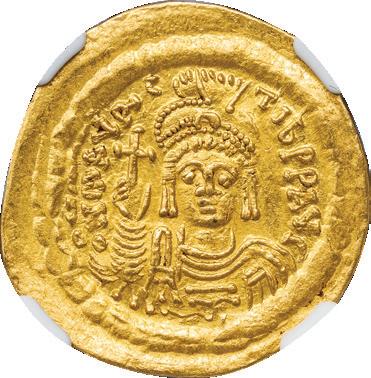
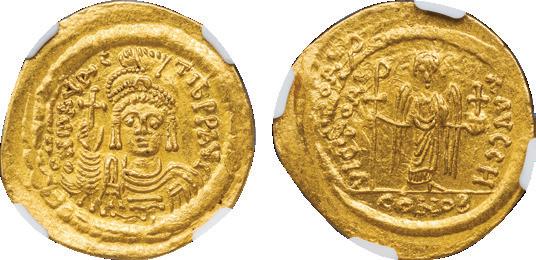

$ 1200
19461. BYZANTINE EMPIRE. MAURICE TIBERIUS, AD 582–602. Gold solidus, 4.31 g, 22 mm. Issue of Constantinople, officina H. Obv. O N MAVRC TIB PP AVC, helmeted, draped and cuirassed bust facing, holding globus cruciger. Rev. VICTORIA AVCC H, Angel standing, facing, holding staff with staurogram and globus cruciger, CONOB in exergue. Sear 478.
NGC graded CHOICE AU, Strike 3/5, Surface 4/5, “die shift,” attractive and lustrous.
This ancient minting error shows a double strike where the second impression was applied more properly centered than the first. Traces of the first impression appear on the obverse’s lower left where the legend is doubled and more prominently on the reverse where the Victory’s staurogram and section of the legend appear twice at upper left. $ 750
28
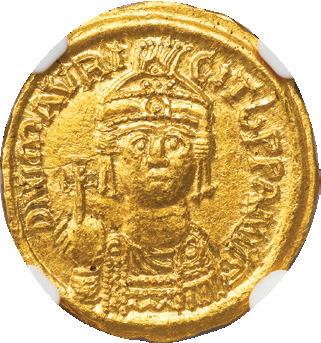
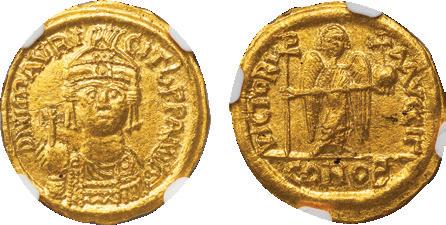
19442. BYZANTINE EMPIRE. MAURICE TIBERIUS, AD 578–602.

Gold solidus, 4.42 g, 19 mm. Issue of Carthage, minted indiction year 13 (AD 594/5).
Obv. DN MAVRICI TIB P P AN IΓ (= year 13), helmeted, draped and cuirassed bust facing, holding globus cruciger. Rev. VICTORIA AVCC IΓ, Angel standing, facing, holding staff with staurogram, CONOB in exergue.
Sear 549; DOC 227.
NGC graded AU, Strike 4/5, Surface 4/5, “rv marks.” An extremely rare emission, this specimen is one of 3 on CoinArchives. $ 950
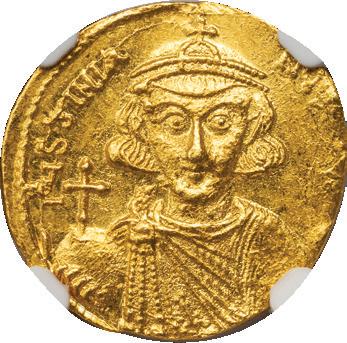
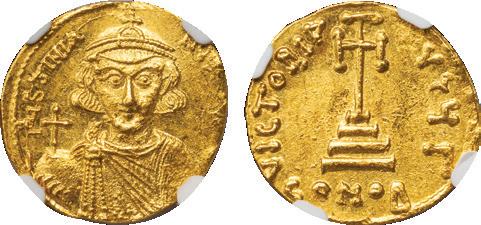
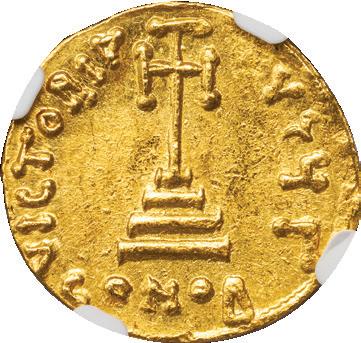
19444. BYZANTINE EMPIRE. JUSTINIAN II, FIRST REIGN, AD 685–695.
Gold solidus, 4.27 g, 19 mm. Issue of Constantinople, officina Γ.
Obv. d IЧStINIA–NЧS [PЄ AV], draped bust of young Justinian II facing, wearing crown with cross and holding globus cruciger. Rev. VICTORIA AVϚЧ Γ, cross potent on three–stepped base, CONOB in exergue.
Sear 1243.
NGC graded MINT STATE, Strike 4/5, Surface 4/5, “clipped,” a rare early emission with a portrait of the devout emperor who introduced Christ’s image on coinage. This variety shows a youthful portrait of Justinian who ascended the throne at 16, his elongated and expressive face engraved with great care. $ 1350
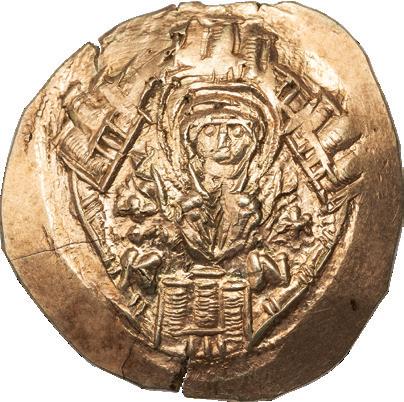
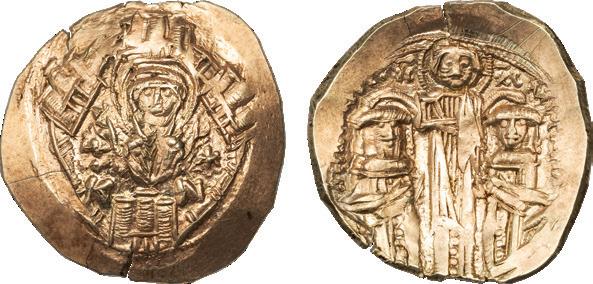
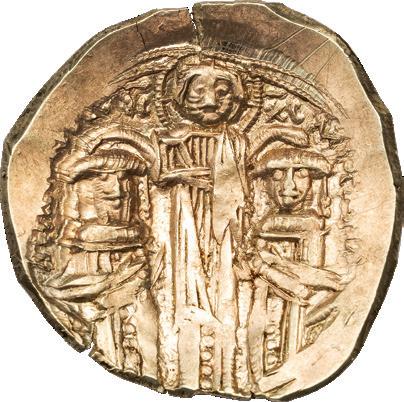
19376. BYZANTINE EMPIRE. ANDRONICUS II & MICHAEL IX, AD 1294–1320. Gold/electrum hyperpyron, 3.68, 24 mm. Issue of Constantinople.
Obv. Virgin orans standing within the city walls of Constantinople. Rev. Christ standing, facing, blessing the two emperors kneeling on either side.
Sear 2396.
Ex Bob Guynn collection, ex Edward J. Waddell, Auction II, 9/12/1987, lot 766 (with original ticket).
NGC graded CHOICE AU, Strike 5/5, Surface 3/5, “marks,” an iconic late Byzantine type depicting the Virgin inside Constantinople’s walls, her hands raised in prayer, symbolically blessing and protecting the city. This specimen is superlative for this often poorly produced issue, struck from fresh dies that render full details throughout. $ 2250
29
32





















































































































































































































